Most Popular Chicken Breeds in Every U.S. State in 2024
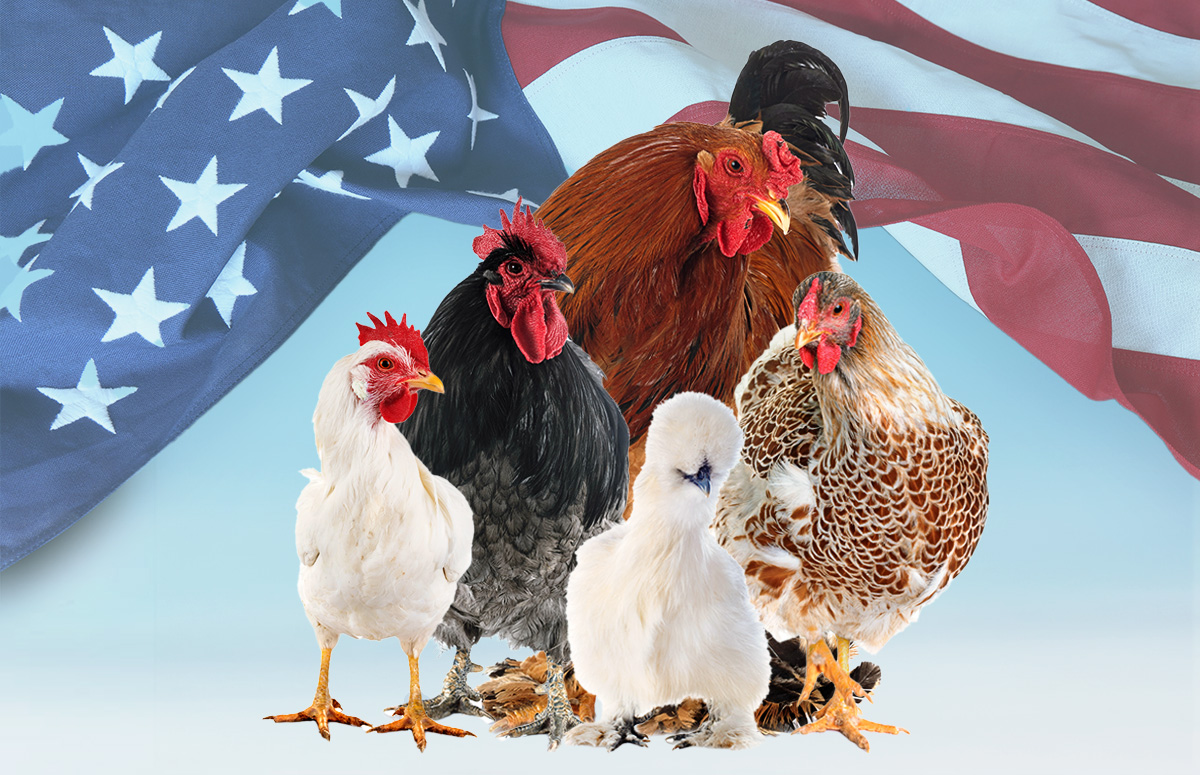
Backyard chickens are a beloved part of American life, and with more than 500 breeds to choose from, figuring out the favorites is no small feat. Using extensive data from our website and other resources, we’ve sifted through the numbers to spotlight the top chicken breeds over the past year. The data reveals global and local trends from coast to coast.
Here is what we will tackle:
- Winners Across the states
- Top 10 Breeds Nationwide
- State-by-State Deep Dive
- Top 10 Breed Profiles
- Beyond the Top 10
Here are the main takeaways and global trends:
- Silkies are in the top 5 in every state
- Americans prefer large and hardy egg-layers
- Some states show strong regional preferences
- Buff Orpingtons & White Leghorns are the most popular egg-layers
- Brahmas, Wyandottes & Orpingtons are popular in colder states
State-by-State Winners: The The Top 2 Breeds Across America
The fluffy Silkie takes the No. 1 spot. It is by far the most searched-for chicken breed in the U.S., ranking first in 43 states. Only in colder states like Alaska, North Dakota, South Dakota, Montana, and Vermont are breeds like the Brahma, Orpington, and Wyandotte favored for their cold hardiness.
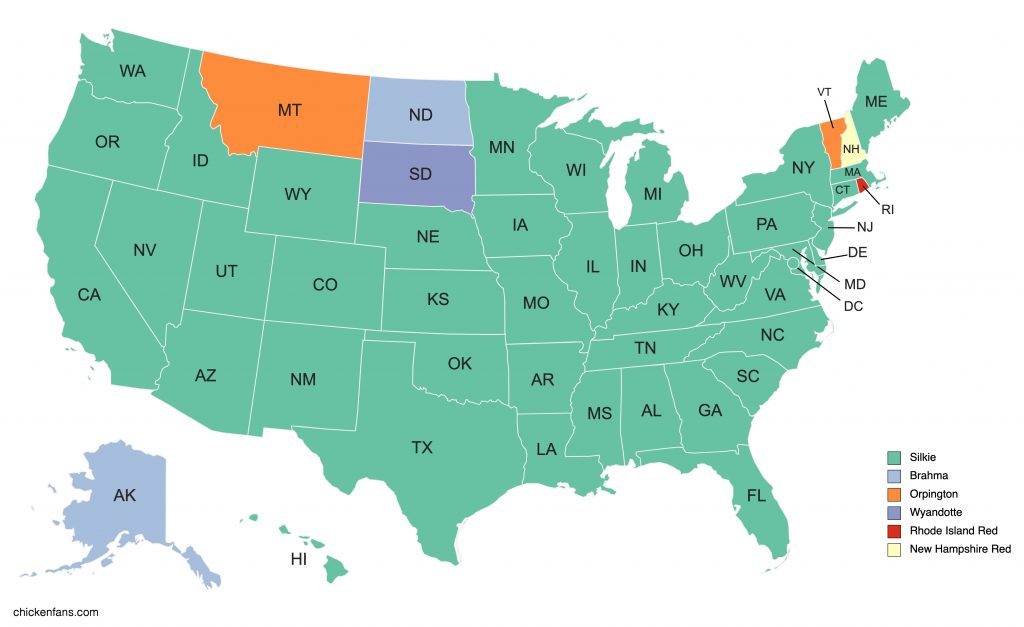
Exceptionally, Rhode Island and New Hampshire diverge from the national trend, favoring their eponymous breeds, the Rhode Island Red and the New Hampshire Red.
Looking beyond the first spots, the U.S. favors a variety of larger, egg-laying chicken breeds. Many people keep Orpingtons, Wyandottes, Plymouth Rocks, and Brahmas for their eggs. The Leghorn, third overall, is a national favorite that can lay over 300 white eggs per year.
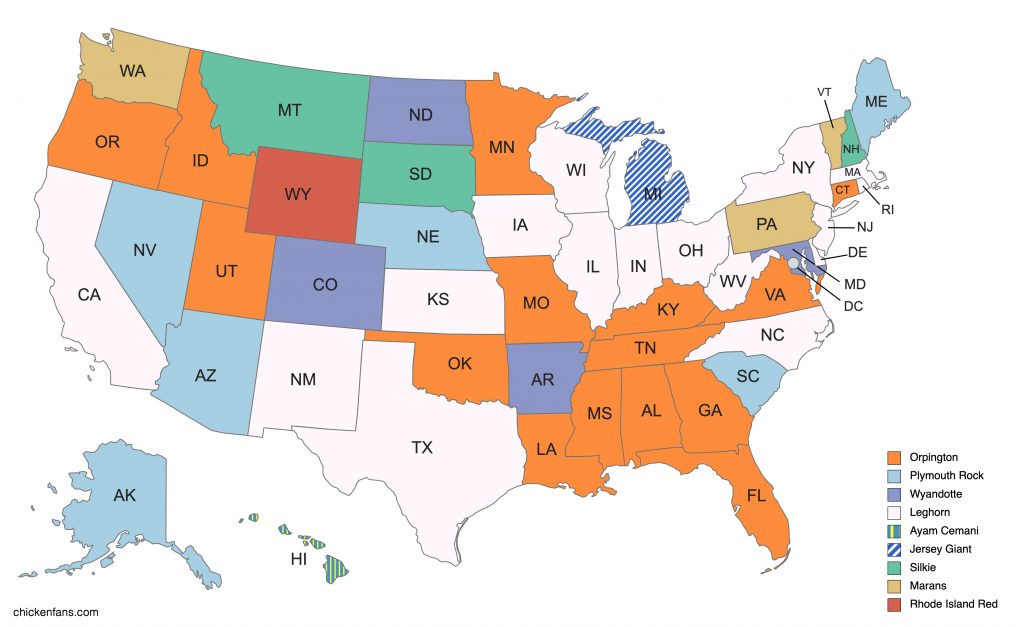
Before delving into the detailed popularity statistics of each state, let’s first examine the overall nationwide perspective.
Top 10 Chicken Breeds in the USA
The bar chart below clearly shows the Silkie’s dominance in the top 5 searches across all 50 states. Following closely is a group consisting of Orpingtons, Leghorns, Wyandottes, Plymouth Rocks, and Brahmas, each securing a spot in the top 5 in over 28 states.
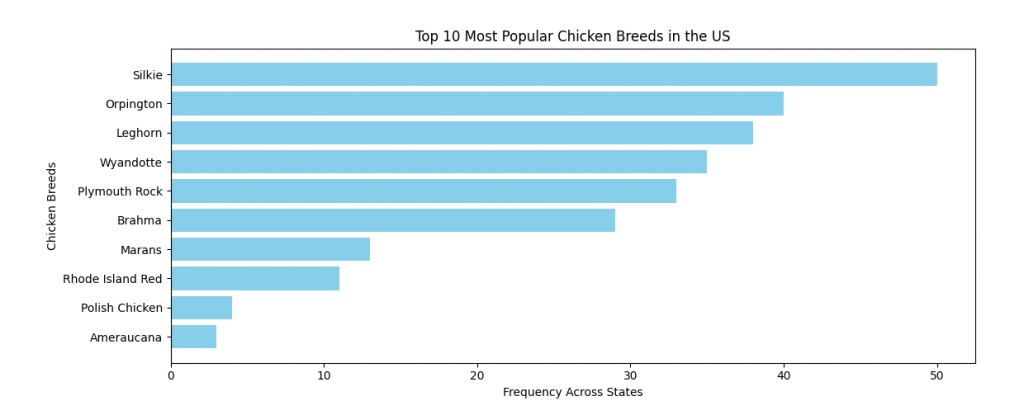
Beyond the top, a significant gap leads to a smaller group of Marans, famous for their dark brown eggs, and Rhode Island Reds, a hardy dual-purpose breed.
The top 10 is rounded off by the crested Polish chickens famous for their iconic look, and Ameraucanas, one of the few breeds laying blue eggs.
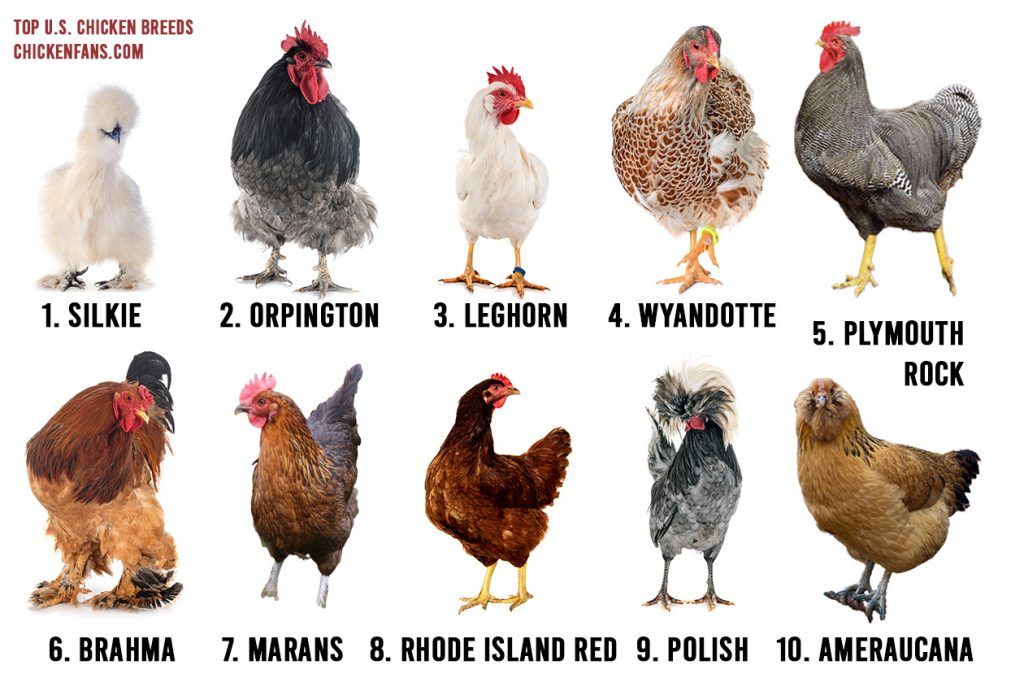
If we take into account the actual position in the top 5 rather than mere occurrences, we can see how much more popular Silkies are compared to other breeds. The Silkie leads with an impressive 237 popularity points, significantly outpacing the Orpington at 124 points.
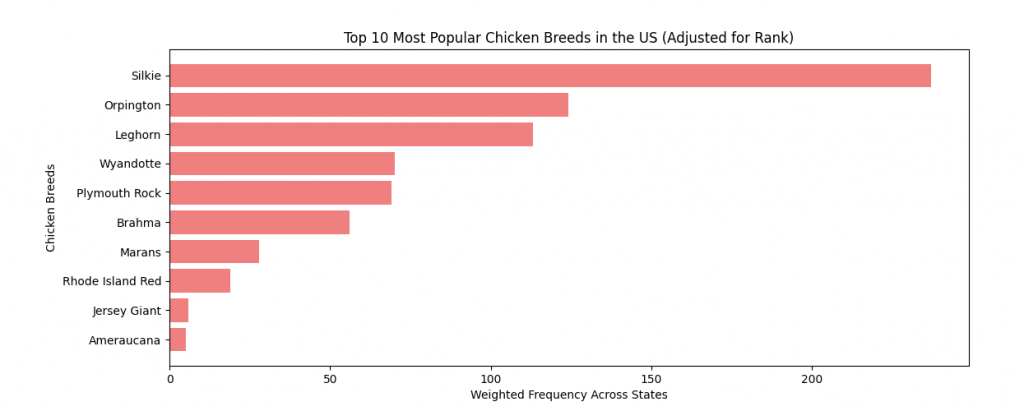
Notably, the Jersey Giant emerges in the top 10, buoyed by its significant appeal in New Jersey and Michigan, possibly influenced by the popularity of Jersey Giant Subs, a sandwich bar chain.
Chicken Breed Popularity by State
Select a state to uncover unique insights into each region’s chicken breed preferences. The percentages in the bar charts represent the distribution within the top 5 breeds, totaling to 100%.
Alabama
In Alabama, the Silkie is almost twice as as much searched for as its first contender, the Orpington, and is especially popular in the Dothan area.
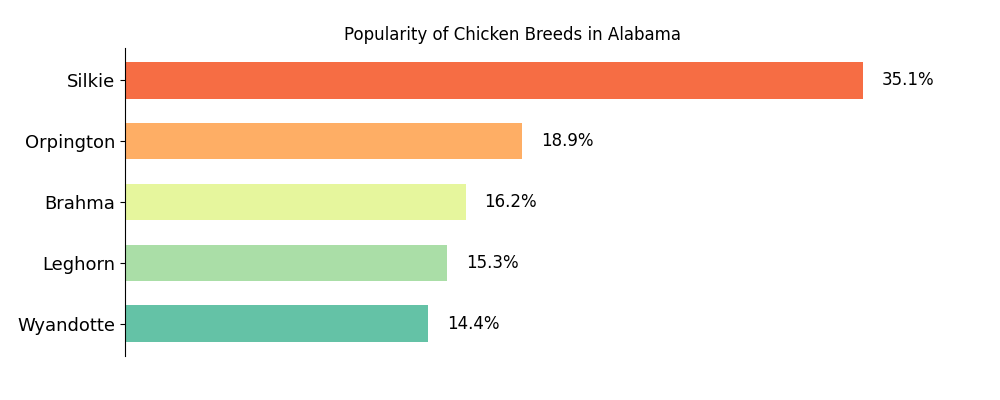
While the cute and fluffy Silkie is a popular pet chicken, the others are all magnificent egg layers.
Orpingtons, particularly the Buff Orpington, are favored throughout Alabama, with their highest popularity in the Huntsville-Decatur-Florence region of northern Alabama. Orpington hens are large and gentle, with heavy plumage, and lay around 250 large light brown eggs annually.
Following closely are the giant Brahmas, often hailed as the King of Poultry. Brahma chickens are by far the most searched-for in Albertville, but their popularity is on the rise across Auburn, Mobile, Dothan, and Birmingham.
Leghorns, celebrated for their egg-laying efficiency, are notably popular in Albertville and Huntsville, with a growing interest in Mobile. Their hardiness and productivity make them a practical choice for Alabama’s poultry enthusiasts.
Wyandottes are closing the top 5 in Alabama. With their large round bodies, they stand out in Huntsville and have significant popularity in Birmingham. Wyandotte hens lay around 200 large brown eggs per year.
Alabama’s enthusiasm for poultry extends beyond backyard coops, with various events and exhibitions showcasing different breeds. These events are popular among chicken fans.
One such event is the Silkie Spring Fling, held annually in Anniston, dedicated to Silkies. This all-Silkie show includes both open and youth categories, providing a focused platform for fans and breeders to showcase their unique chickens.
Alaska
Alaska is one of the only States where the Silkie is not taking the top spot:
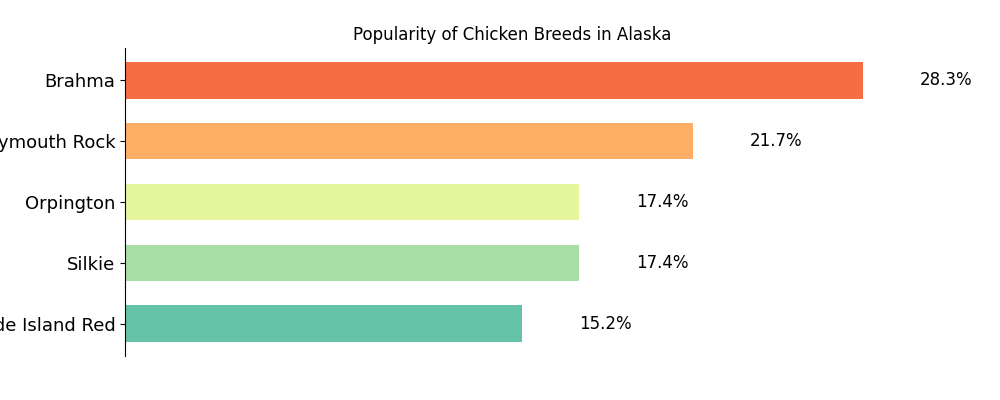
In the rugged Alaskan backyard, the Brahma has earned its place at the top of the pecking order. It’s a cold-hard, heavyweight breed with a robust build and heavily feathered legs, making it exceptionally well-suited to Alaska’s harsh climate.
Breeds like the Brahma, Plymouth Rock, Orpington, and Rhode Island Red are great egg-layers known for their cold tolerance and popular choices in Alaska.
Arizona
In the scorching Arizona sun, the Silkie takes the crown as the most favored chicken breed.
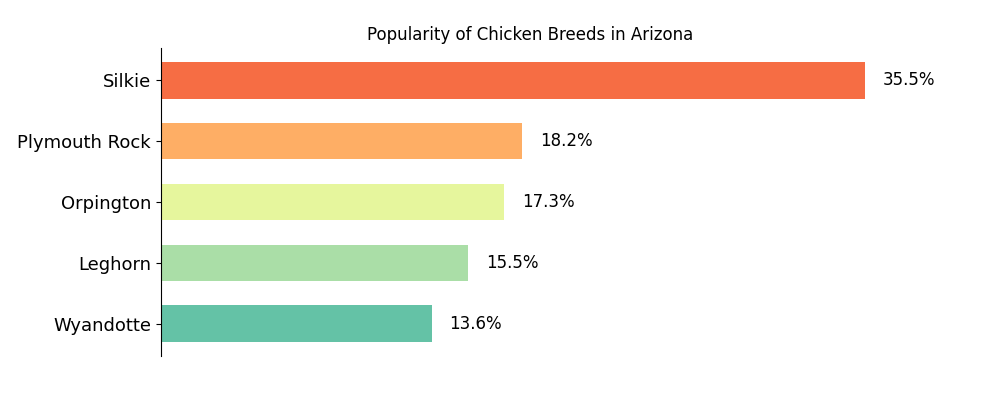
It shouldn’t be a surprise that the Leghorn is on the list. It’s a heat-resistant Mediterranean breed that can lay over 300 eggs annually.
However, while not the most heat-resistant, Plymouth Rock and Orpington are still popular due to their versatility, overall hardiness, adaptability, and reliable egg production.
Arkansas
In Arkansas, the fluffy Silkies take the lead in the popularity charts.
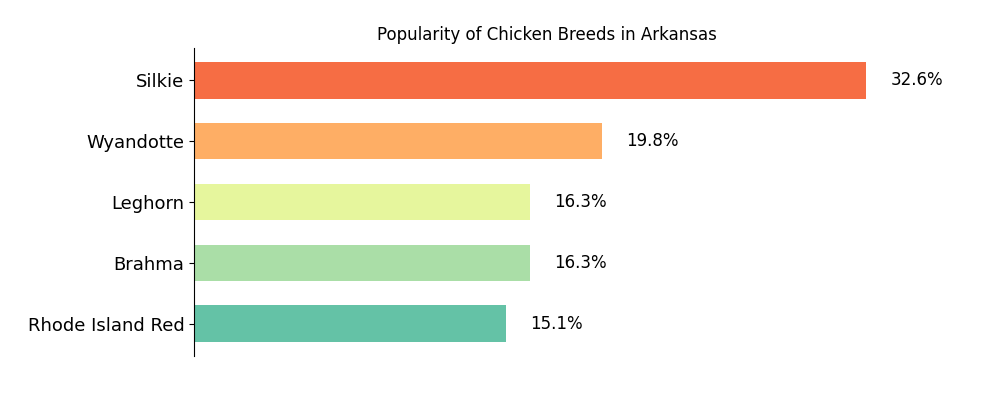
Next on the list are Wyandottes, a breed that resonates with Arkansas’s tradition of favoring visually striking and robust chickens, ideal for the state’s varied climate.
Leghorns, a nod to Arkansas’s status as a leading egg producer, are celebrated for their consistent and high-volume egg-laying, aligning with local farmers’ practical and economic needs.
The stately Brahma, with its impressive stature, especially appeals to those in the more spacious rural landscapes of Springfield. Where there’s more open space and a strong agricultural presence, breeds like the Brahma often thrive and become favored among poultry enthusiasts.
California
In sunny California, fluffy Silkies are the absolute stars of the chicken world. California’s love for Silkies is unmatched nationwide, boasting the highest popularity numbers across all states.
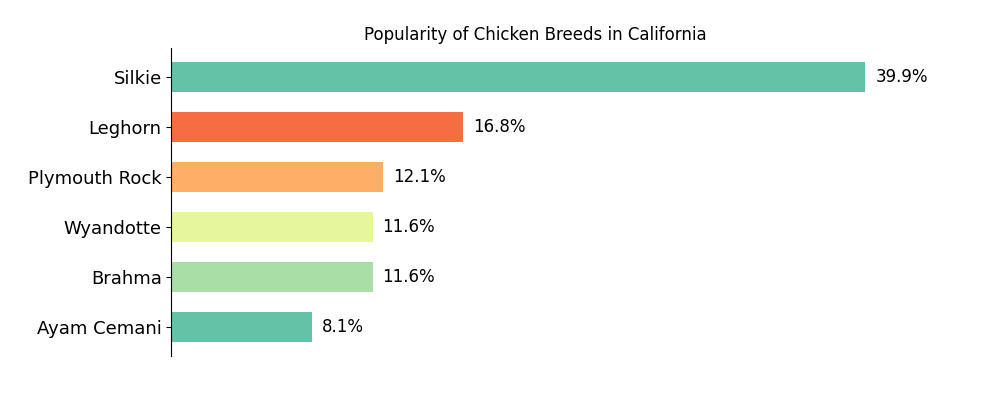
While Silkies are the undisputed favorites in the Golden State, the egg-laying Leghorns are doing surprisingly well. The popularity of Leghorns in California reflects a broader trend toward sustainability and self-sufficiency.
Next on the list are some usual suspects. The barred Plymouth Rocks, the beautiful round Wyandottes, and the majestic Brahmas – the gentle giants of the chicken world.
One breed narrowly missed the top 5, coming in 6th place, but we felt it deserved a special mention. In the eclectic and trend-setting state of California, the Ayam Cemani, a rare and exotic breed known for its striking all-black appearance, has surprisingly clucked its way into the hearts of poultry enthusiasts.
The popularity seems to mirror California’s fascination with the unique and unconventional. The Ayam Cemani’s jet-black feathers, skin, and even bones offer a mystique that resonates with those seeking a chicken breed as distinctive and stylish as their lifestyle.
Colorado
The popular fluffy pet Silkie breed tops the chicken popularity chart in Colorado.
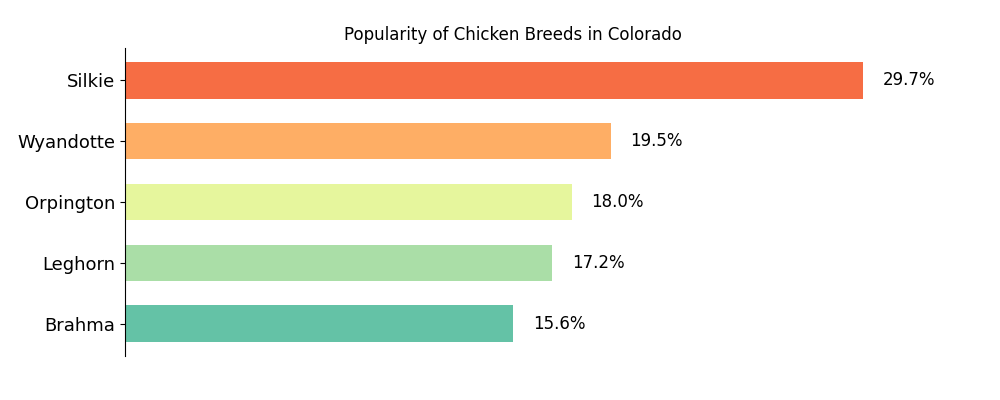
The rugged and varied climate of the state makes it an ideal place for hardy breeds like Wyandottes, Orpingtons, Brahmas, and Leghorns.
Given its prolific egg-laying abilities, the Leghorn’s fourth-place popularity speaks to Colorado’s interest in sustainable living and urban farming.
Brahma chickens are especially popular in Grand Junction – embodying the area’s majestic serenity and slow-paced charm through its impressive presence and tranquil nature.
Connecticut
Like in most states, the fluffy Silkies lead the pecking order in the popularity charts:
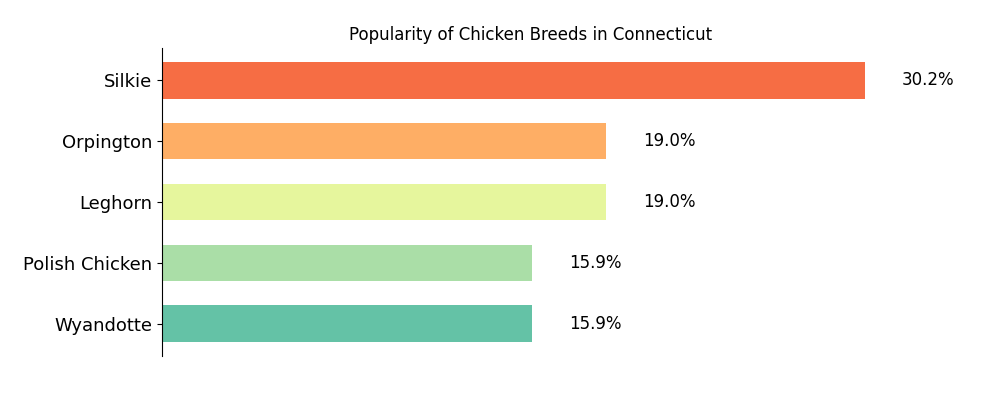
Orpingtons and Leghorns, tied for second place, highlight Connecticut’s appreciation for both the aesthetic appeal and practical utility of poultry. Orpingtons, with their fluffy plumage and friendly demeanor, and Leghorns, that can lay over 300 eggs a year.
Remarkably, the Polish Chicken, with its unique feathered crest, claims the fourth position, the highest ranking it enjoys in any state across the U.S. Illinois is the only other state where the Polish Chicken made it to the top five.
It’s unclear to us why the Polish is so much searched for in Connecticut, but it seems that its distinctive appearance and spirited personality are appealing in a state that values uniqueness and a touch of old-world flair.
Delaware
Like in most states, the fluffy Silkie is the most popular chicken in Delaware. However, the gap with the other breeds is not that huge.
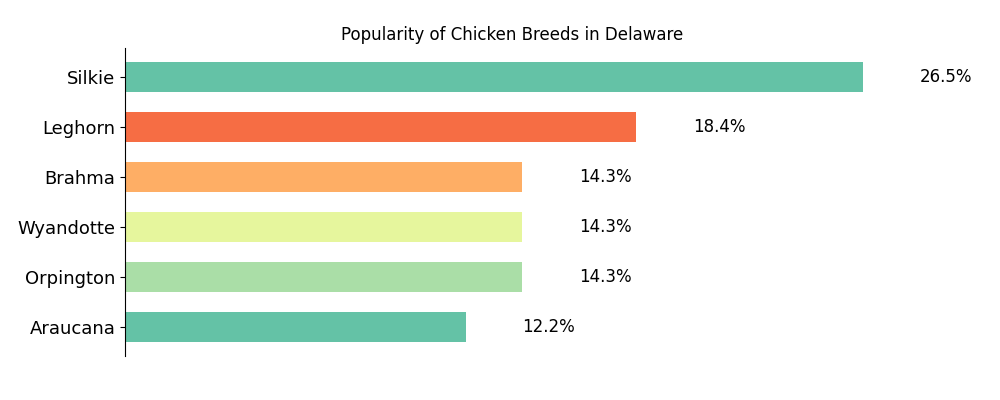
Despite being one of the smallest states in the U.S., Delaware has a strong and passionate community of backyard chicken enthusiasts. Delaware’s moderate climate allows for various chicken breeds to thrive, making it a hotspot for a whole bunch of popular breeds.
The second most popular chicken breed is the Mediterranean Leghorn, which can lay over 300 eggs yearly. The Brahma, Wyandotte, and Orpington breeds share a three-way tie for the third place in popularity among Delaware’s chicken fans.
Just narrowly missing the top five and landing in sixth place is the Araucana. The Araucana is a beautiful chicken with unique ear tufts that is famous for laying blue eggs.
Florida
In Florida, the fluffy Silkie leads the popularity charts. Especially Miami, known for its vibrant culture and eclectic tastes, has a particular sweet spot for Silkies. They are more than twice as much searched for as the other contenders in the top 5: the Orpington, Leghorn, Brahma, and Wyandotte.
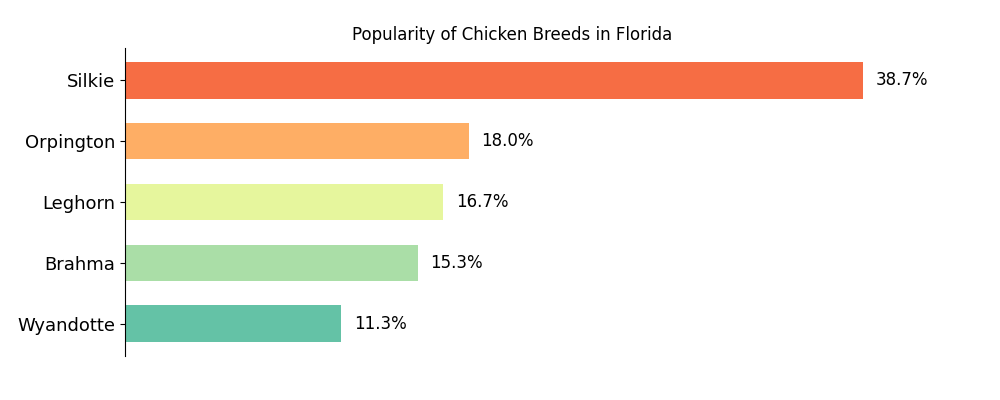
Whereas all those contenders are great egg-layers, the Leghorn is the most prolific and can lay over 300 eggs per year. Leghorns are a sensible choice in a state that values both agricultural productivity and backyard farming.
Orpingtons, with their fluffy feathers and friendly personalities, fit perfectly into the laid-back, family-friendly lifestyle prevalent in many Floridian communities. The large size and calm demeanor of Brahma chickens make them popular in more spacious rural or suburban areas of Florida.
We were hoping to see some more exotic breeds on the list here. In the realm of Florida’s diverse chicken-keeping scene, there is Greenfire Farms, a hatchery that focuses on special breeds, such as the Swedish Flower Hen.
Greenfire Farms represents a facet of Florida’s chicken community that values quality, welfare, and the preservation of rare breeds, catering to those who seek more than just a backyard chicken.
Georgia
In Georgia, the charming Silkies are by far the most searched for and lead the popularity charts.
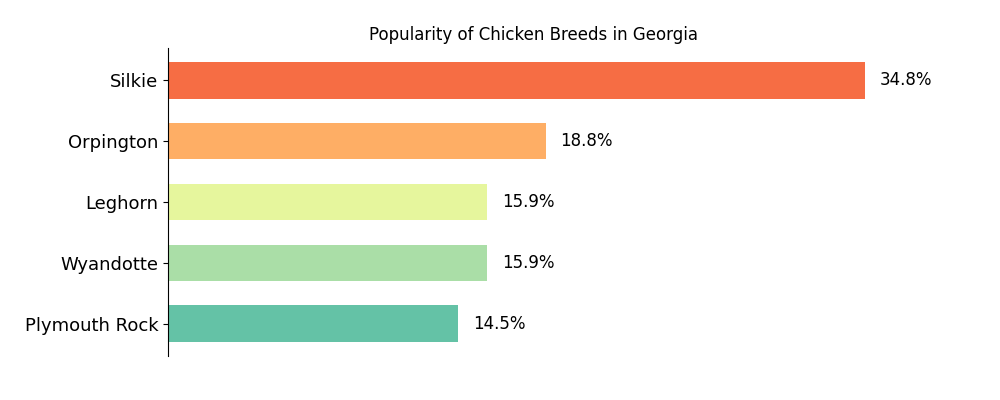
Following the Silkies, Orpingtons hold the second spot. Fluffy Orpingtons are child-friendly dual-purpose chickens, offering both egg-laying prowess and meat, which seems to align with Georgia’s practical approach to farming and self-sustainability.
Leghorns and Wyandottes are tied for the third place; both are great egg layers. However, the Leghorn is the king of eggs, sometimes laying over 300 eggs yearly.
The Leghorn captures most attention around Thomasville and the areas close to Dothan. Its popularity fits well with local preferences for productive and efficient backyard chickens.
In Georgia, with its rich history in agriculture and a community that values outdoor living, backyard chicken keeping is more than just a pastime; it’s a way of life.
The barred Plymouth Rock takes the last spot in the top 5. They are hardy chickens, reliable layers, and suitable for backyard farming.
Hawaii
Hawaii’s got a wild side with its free-roaming feral chickens. There are chickens everywhere: on the streets, parking lots, and hiking trails. But still, the fluffy Silkie is the most searched-for breed, leading the popularity chart.
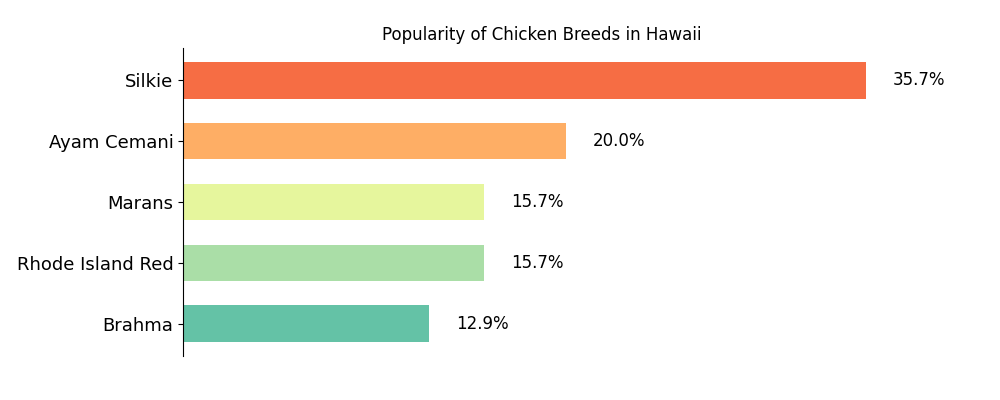
Surprisingly, the Ayam Cemani is the second most searched-for chicken in Hawaii. These birds are all black, from feathers, comb, and wattles to bones and meat, giving them a unique appearance.
However, it’s a very rare breed, and acquiring the black birds poses challenges due to the lack of local NPIP-certified hatcheries and the stringent regulations governing the import of poultry into the state.
Marans and Rhode Island Reds are tied for the third place. The Marans chicken is known for its dark chocolate-colored eggs. The Rhode Island Reds are popular all over the US for their robustness and egg-laying abilities.
The Brahma rounds out the top five. These giant but gentle chickens seem to appeal to those in Hawaii seeking a calm and majestic presence in their backyards, akin to the tranquil and grand landscapes of the islands.
Idaho
Silkies take the top spot in Idaho, but their lead isn’t as commanding as in other states.
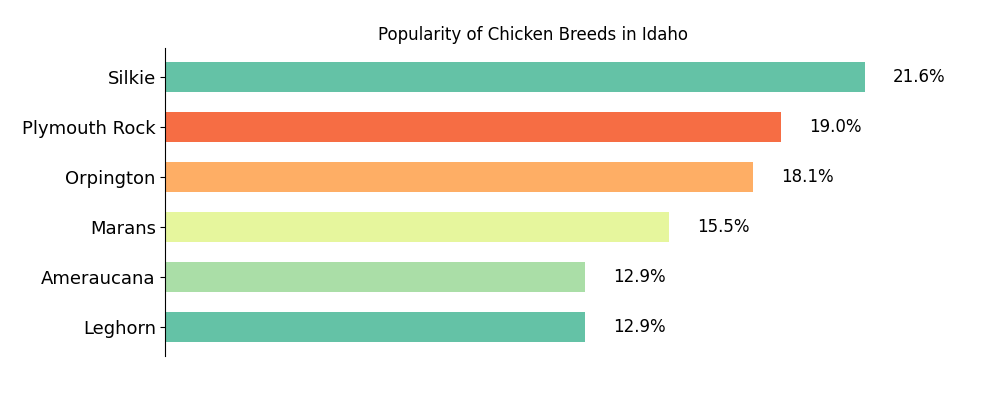
Not far behind are the steadfast Plymouth Rocks, favored for their dual-purpose qualities, both as reliable layers and for their meat.
A notable trend in Twin Falls stands out: chicken fans here are singularly focused on either Silkies or Plymouth Rocks, with seemingly little interest in other breeds.
With their friendly nature and fluffy feathers, the Orpingtons are nipping at the heels of the top two, showcasing Idaho’s penchant for both beauty and utility in their poultry choices. The Marans, known for their rich, chocolate-brown eggs, are also climbing the popularity ladder.
Tied in the fifth spot are the muffed and bearded Ameraucanas, popular for their blue eggs, and the ever-efficient Leghorns, famous for their prolific egg-laying abilities.
Idaho is the only state where the Ameraucana makes it into the top five. The breed’s popularity is supported by local hatcheries like Sheppard Ranch and Dunlap Hatchery, which cater to the growing demand for these distinctive egg layers.
Illinois
In Illinois, the fluffy Silkies take the top spot and are the most searched-for breed. The ever-reliable Leghorns, known for their prolific egg-laying, cluck in at second.
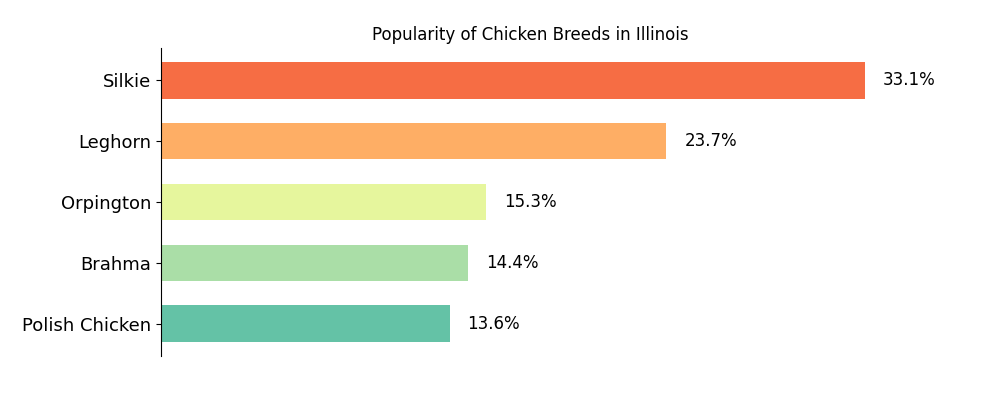
With their friendly demeanor and fluffy plumage, Orpingtons hold a solid third place, while the majestic Brahmas, known for their size and gentle nature, follow closely.
Unique to Illinois is that the Polish Chicken, with its eye-catching crest of feathers, secured the fifth spot. They are especially searched for in southeastern Illinois, near Terre Haute, Evansville, and Effingham. This area shows an exceptional fondness for Polish chickens, adding a dash of flair to Illinois’ otherwise practical poultry scene.
Indiana
With their distinctive fluff plumage, Silkies lead the popular pack statewide and are Indiana’s most searched-for chicken breed, particularly in Terre Haute, where their popularity is unmatched.
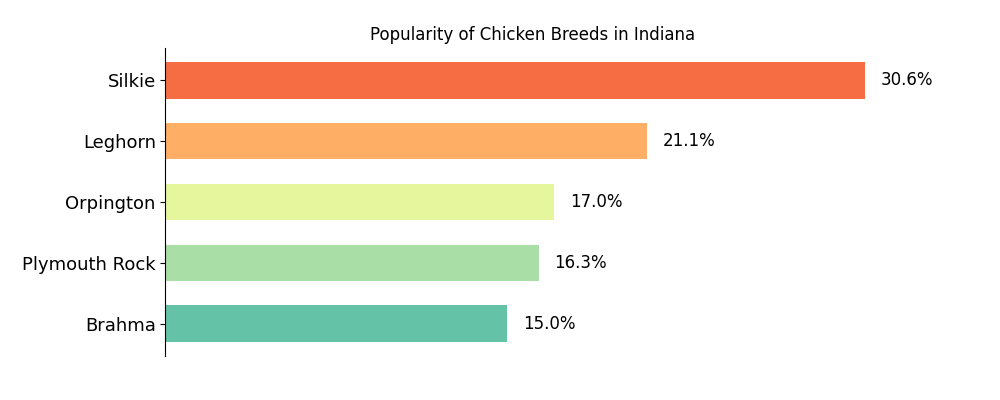
Following close behind are the Leghorns, known for their prolific egg-laying abilities, as some birds can lay over 300 eggs per year.
Leghorns make a significant mark in Evansville, where they share the spotlight with the majestic Brahmas, appreciated for their size and gentle nature.
Orpingtons, known for their beautiful, fluffy plumage and easy-going temperament, also have a strong following, particularly in Terre Haute alongside the Silkies.
The dual-purpose and hardy Plymouth Rock holds its own and takes the fourth spot in the list.
Iowa
Silkies, with their unique fluffy appearance and friendly nature, are the most searched-for breed in Iowa.
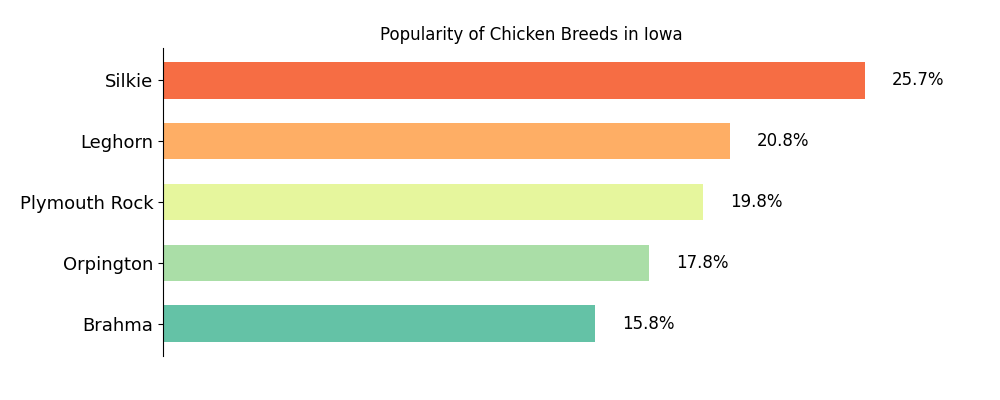
Close behind in popularity are the efficient Leghorns, appreciated for their prolific egg-laying capabilities. Some Leghorns can lay over 300 eggs per year.
The Plymouth Rock, another well-rounded breed great for eggs and meat, takes the third spot. Orpingtons are almost as popular with their plush feathers and round bodies. With their impressive size and calm temperament, Brahmas round out the top five.
The presence of two major hatcheries within Iowa, McMurray Hatchery and Hoover’s Hatchery, likely shapes the state’s chicken breed preferences. These hatcheries provide a wide variety of breeds to choose from and serve as educational and community hubs for poultry enthusiasts.
The Master’s Cup Poultry Show at the Hamilton County Fairgrounds, in the hometown of Murray McMurray Hatchery, further highlights Iowa’s engaged chicken community. This event, among others, offers a platform for breeders and enthusiasts to showcase their birds.
Kansas
Silkies are the most searched-for breed in Kansas, capturing hearts with their unique fluffy plumage.
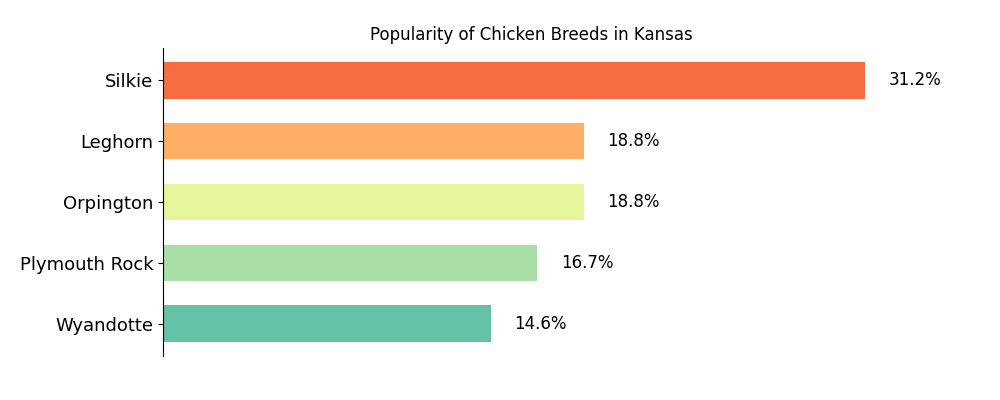
They’re followed by Leghorns and Orpingtons, both equally cherished for different reasons. Leghorns are prized for their exceptional egg-laying prowess, aligning with the state’s agricultural productivity. On the other hand, Orpingtons, with their fluffy plumage and gentle nature, strike a perfect balance between being ornamental and utilitarian.
Fourth on the list are the barred Plymouth Rocks, known for their hardiness and versatility. Closing the list are the Wyandottes, known for their beautiful plumage and round bodies.
Kansas seems to prefer chickens that are as hardy as they are attractive. This list of breeds underscores the state’s rich tradition of poultry keeping, where functionality meets aesthetic appeal.
Kentucky
In Kentucky, Silkies are the most popular and searched-for chicken breed. Their fluffy plumage and engaging personality make them the top choice among Kentucky’s chicken fans.
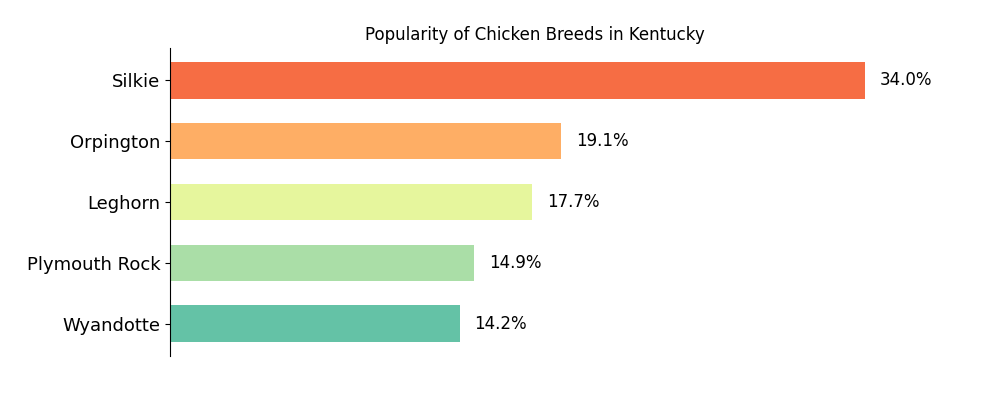
The other contenders in the top 5 are relatively close to each other. Orpingtons, known for their fluffy feathers and friendly nature, also enjoy significant interest.
Leghorns, celebrated for their prolific egg-laying capabilities, take the third spot. They are particularly searched for in Lexington, indicating the city’s appreciation for practical and efficient poultry breeds.
Meanwhile, the Plymouth Rock, a popular dual-purpose breed, has carved out its niche in Louisville, echoing the city’s balance of urban and rural lifestyles.
The Wyandotte closes the top 5. Their fluffy plumage and round bodies are especially popular in Bowling Green.
Not on the list, but interesting to mention: in Shepherdsville, the Brahma breed stands out for its popularity, its majestic stature and gentle temperament resonating with the local community’s preference for larger, robust breeds.
Louisiana
Silkies are leading the charts in the Pelican State. With their distinctive fluffy plumage and friendly personalities, they are the most searched-for chicken breed.
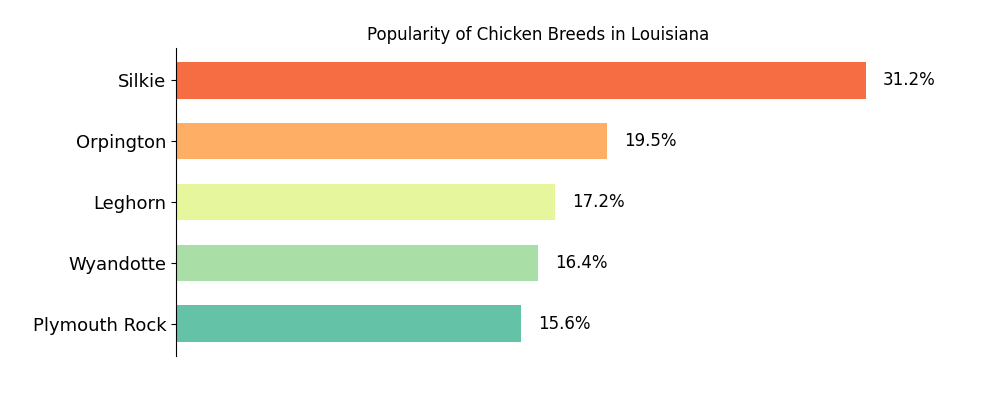
Following the Silkies are the Orpingtons, cherished for their beautiful plumage and gentle nature.
Third on the list are the Leghorns, known for their efficient egg-laying. Some birds can lay over 300 eggs annually and are valued for their practical contributions to homesteads. Leghorns are especially popular in Baton Rouge, but there is also some interest in New Orleans.
Wyandottes, with their round and robust bodies, and Plymouth Rocks, a hardy dual-purpose breed, also feature prominently, showcasing Louisiana’s appreciation for versatile and hardy breeds.
Maine
In Maine, where strong winters define much of the year, Silkies are still the most searched-for chicken breed. Not by much, however, as there seems to be a thoughtful balance between hardiness and charm.
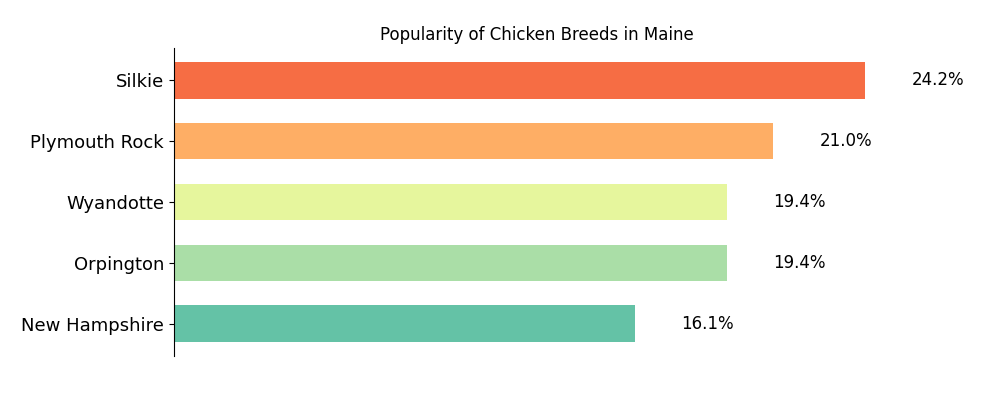
The Plymouth Rock, a steadfast and cold-hardy breed, is second on the list in Maine, where Lisa Steele popularizes natural backyard chicken keeping. The Plymouth Rock chicken breed originated in the United States in the mid-19th century and was developed in New England. They are suitable for braving Maine’s long winters while still providing reliable egg production, even in colder months.
Wyandottes and Orpingtons share the third place on the popularity charts. They can withstand the harsh winters while still adding a touch of warmth to the coop with their looks and docile personality. Both Wyandottes and Orpingtons are well-suited to the chilly weather, with their thick feathers providing extra insulation.
Remarkably, the New Hampshire Red chicken makes its mark in Maine’s top five. They are especially popular in the Portland-Auburn area near the New Hampshire border. New Hampshire chickens are known for their early maturity and robustness and are particularly well-adapted to the Northeast’s challenging winters.
Maryland
In Maryland, Silkies are the most searched-for chicken breed. With their fluffy plumage, they are almost twice as popular as the other contenders on the list.
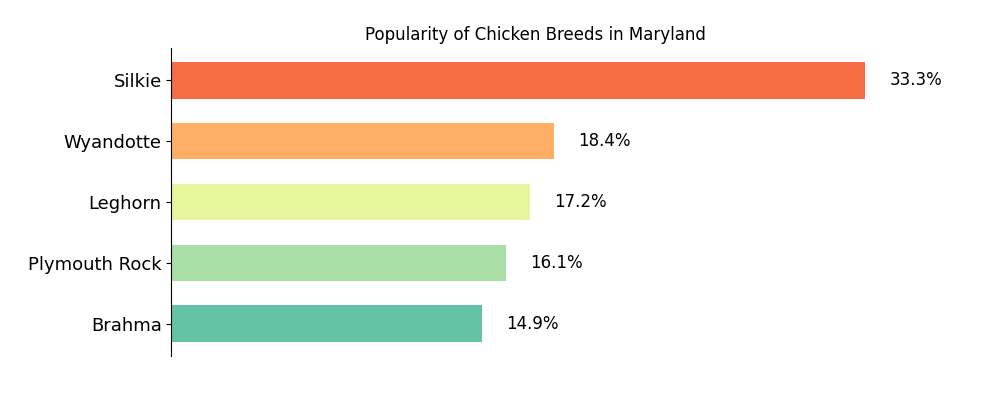
The Wyandottes follow the Silkies, known for their amazing plumage and robust nature. The Leghorn, known for its prolific egg-laying capabilities, is almost as popular as the Wyandotte.
Plymouth Rocks, another well-loved breed, offer versatility and reliability. Not surprisingly, they are ideal in a rich mix of urban and rural landscapes. Looking closer at the data, we see that Plymouth Rocks are especially popular in Hyattsville. Although we don’t specifically know why that’s the case, Hyattsville is well-suited for Plymouth Rocks with its suburban setting.
Brahmas, known for their impressive size and calm demeanor, not only round out Maryland’s top five but have also found a special place in the hearts of Catonsville’s chicken fans. According to the data, they seem to particularly favor these majestic and gentle giants – but again, we don’t know why.
Massachusetts
In Massachusetts, the fluffy Silkies take the top spot and are the most searched-for chicken breed.
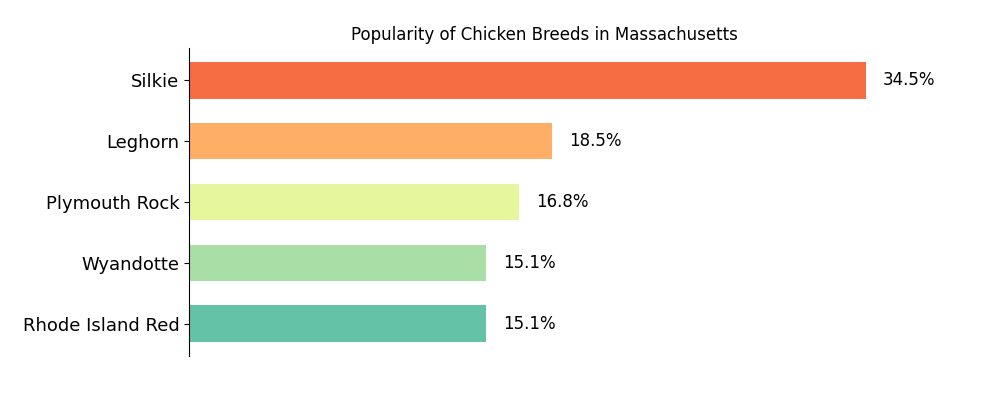
Following the Silkies are the efficient Leghorns, known for their prolific egg-laying abilities. Some Leghorn chickens lay 300 eggs annually. It’s a practical choice for Massachusetts’ diverse range of chicken keepers.
Third on the list is the Plymouth Rock, a breed synonymous with American poultry heritage that holds a special historical significance in Massachusetts. Originating in the state in the nineteenth century, this American breed has long been a cornerstone of chicken farming. You can spot them all over the charts here, as they are celebrated for their cold hardiness, easy management, brown eggs, and tender meat.
The Wyandottes and Rhode Island Reds share the stage, each with its own fan base.
The Rhode Island Red – developed just a stone’s throw away – also carries historical weight. The Rhode Island Red has deep roots not only in its namesake state but also in Massachusetts. Interestingly, it vies for attention with the Plymouth Rock, a breed intrinsically linked to Massachusetts’s past.
The Rhode Island Red, known for its dual-purpose qualities, is popular for both its brown eggs and tasty meat, making it another practical and cherished choice in the state’s diverse chicken-keeping landscape.
Despite Massachusetts’ proximity to New Hampshire, the interest in New Hampshire Reds pales in comparison to the Rhode Island Red, underscoring the unique local preferences that shape the state’s poultry culture.
Michigan
In Michigan, fluffy Silkies lead the popularity contest and are the most searched-for chicken breed.
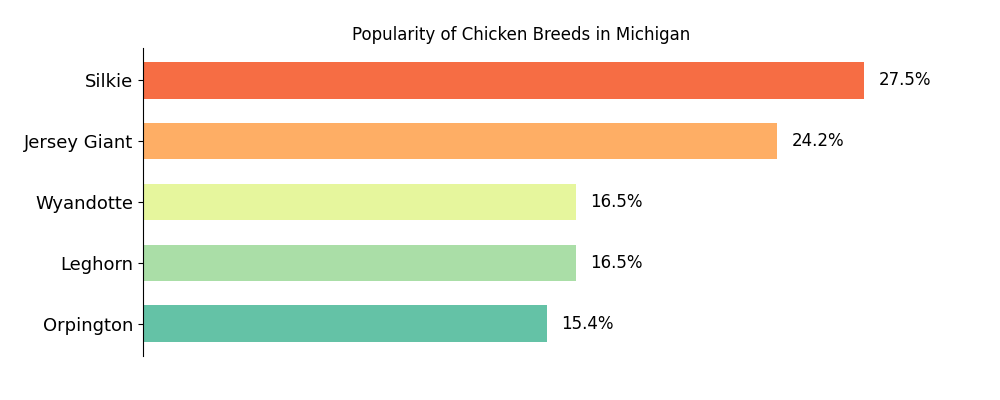
Close behind are the Jersey Giants, known for their impressive size and gentle nature, a breed that seems unusually popular in Michigan compared to other states.
Wyandottes and Leghorns, both tied for the third place, reflect Michigan’s balanced approach to chicken keeping. Wyandottes are appreciated for their beautiful plumage and hardiness, while Leghorns are appreciated for their efficient egg-laying abilities.
With their fluffy feathers and docile temperament, Orpingtons are also on the list, embodying Michigan’s preference for breeds that combine beauty, eggs, and meat.
However, the high number of searches for the Jersey Giant in Michigan has an unexpected twist. The breed’s popularity, particularly in areas like Lansing, Grand Ledge, Delhi Charter Township, as well as Portage and Plainwell, coincides with the locations of Jersey Giant Subs, a popular sandwich bar chain.
Either the presence of these eateries is inadvertently boosting the profile of the Jersey Giant chicken breed, or search engines are misinterpreting people searching for the sandwich bar as looking for the chicken breed. Clearly, it’s the latter.
Minnesota
In Minnesota, the fluffy Silkies top the list as the most searched-for chicken breed, with a particular stronghold in Saint Louis Park.
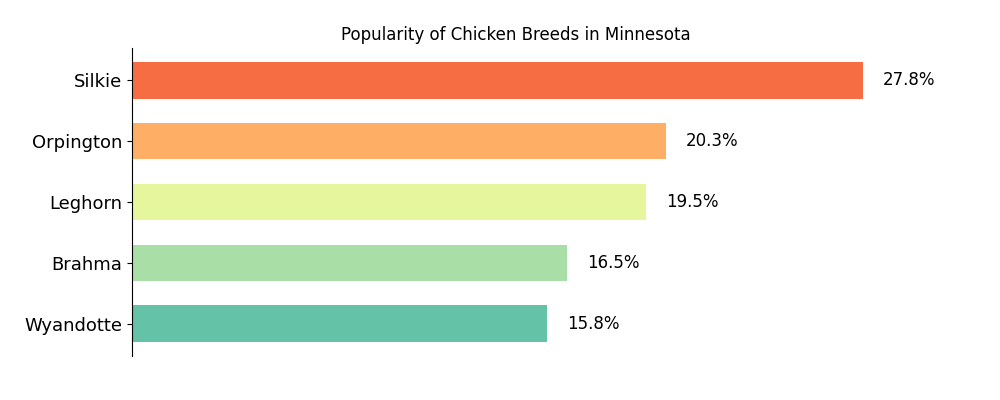
Following the Silkies are the robust Orpingtons. Their fluffy feathers, friendly demeanor, and excellent egg-laying make them a favorite for family-friendly coops in Minnesota’s diverse suburban and rural landscapes.
Leghorns, ranking high for their remarkable egg-laying efficiency, are a practical choice for Minnesotans who value productivity. Some Leghorns lay over 300 eggs per year.
The Brahma, a gentle giant, enjoys particular popularity in Eden Prairie and is notably the most popular chicken in Mankato. Their size and gentle nature make them well-suited for Minnesota’s larger rural spaces, where robust breeds are appreciated for their adaptability to the state’s varied climate.
The Wyandottes, sought after most in Golden Valley, with their beautiful plumage and versatility, complete the list. They fit seamlessly into the Minnesota ethos of resilience, thriving in both the snowy winters and humid summers.
The diversity of Minnesota’s data suggests a regional preference for larger, robust breeds within certain Minnesota communities.
Mississippi
In Mississippi, Silkies lead the popularity chart; with their distinctive fluffy appearance and friendly demeanor, they are the most searched-for chicken breed.
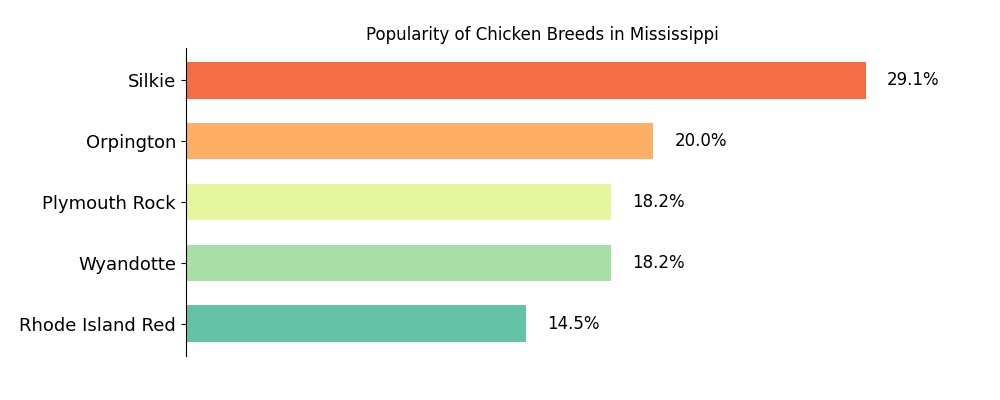
Orpingtons, cherished for their fluffy plumage and docile nature, come in second. Together with Silkies and Rhode Island Reds, they seem to find a special fan base in Hattiesburg.
Plymouth Rocks, known for their hardiness, eggs, and meat, are especially popular in Jackson, indicative of an urban preference for versatile and hardy breeds.
Tied for the third place are the popular Wyandottes. With their round, fluffy body, they are both beautiful and great egg-layers capable of thriving in the humid climate.
The Rhode Island Reds, known for their robust egg-laying capabilities, round out the top five, further emphasizing the state’s practical approach to chicken keeping.
Missouri
Silkies, with their distinctive fluffy feathers and friendly personality, are Missouri’s most searched-for chicken breed. Towns like Marshfield, especially, seem to have an interest in Silkies.
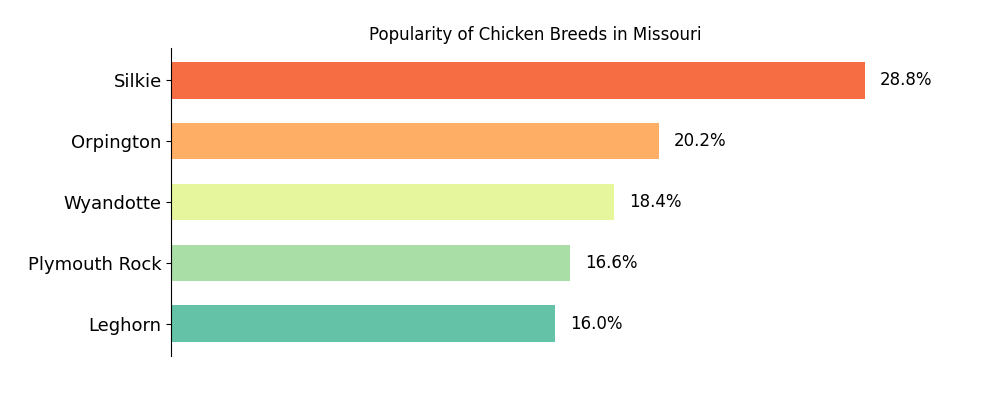
Orpingtons, known for their plush feathers and gentle disposition, come in second. They are both beautiful and great egg-layers. Wyandottes take the third spot and are almost as popular. Both breeds are similar in their appeal and lay well over 200 eggs per year. They offer a blend of beauty, temperament, many eggs, and tender meat.
Next on the list, neck-on-neck, are two hardy and easy-to-maintain breeds that also lay many eggs. The first one is the Plymouth Rock, a popular dual-purpose chicken breed in Missouri, a state with a strong agricultural backbone.
Interestingly, the Leghorn, which can lay over 300 eggs per year, claims the top spot for searches in St. Joseph, suggesting a regional preference for efficiency and productivity in this part of the state.
Missouri is also home to Cackle Hatchery in Lebanon, which popularizes backyard chicken keeping. The hatchery’s annual “Fall in Love with Chicks” festival in Lebanon features various poultry-related activities and a display of diverse breeds.
Montana
Montana is one of the few states where the Silkie isn’t the most-searched-for chicken breed.
Montana experiences a wide range of weather conditions, including cold winters with heavy snowfall. Backyard chicken keepers need to be well-prepared for the extreme cold and favor the cold-hardy yet attractive Orpingtons. These birds have round, full bodies with heavy plumage and are still laying over 250 eggs per year.
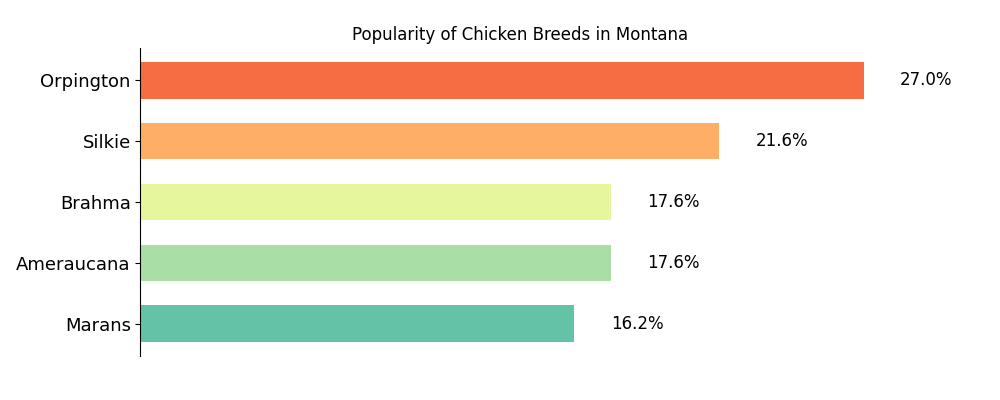
Silkies, with their unique, fluffy feathers and charming personalities, follow closely. However, they are pet chickens and need adequate shelter and insulation in the cold winters. Montana is also home to various wildlife, including foxes, coyotes, and birds of prey, which can pose a serious threat to small chickens like Silkies.
The Brahma and Ameraucana breeds share the next spot, each with its own unique appeal. Brahmas, known for their impressive size and serene temperament, are well-suited for Montana’s spacious rural settings, while Ameraucanas are celebrated for their colorful eggs.
In Montana, the Brahma chicken breed garners the most searches in Butte, accompanied by notable interest in Lockwood and Great Falls. The Ameraucana breed is mostly popular in Missoula, reflecting regional preferences within the state. The popularity of the other chicken breeds, such as Orpingtons, Silkies, and Marans, is evenly spread across the state.
Talking about colorful eggs, the Marans rounds out the top 5. The Marans is a popular beginner-friendly chicken that lays over 200 large dark chocolate-brown eggs.
In Montana, from the Rocky Mountains to the Great Plains, the choice of chicken breeds is a blend of beauty, resilience, and practicality, with each breed bringing its own unique contribution.
Nebraska
The Silkie is leading the charts in Nebraska as the most searched-for breed. With its unique fluffy appearance, the pet chicken is particularly favored in cities like Lincoln and Omaha.
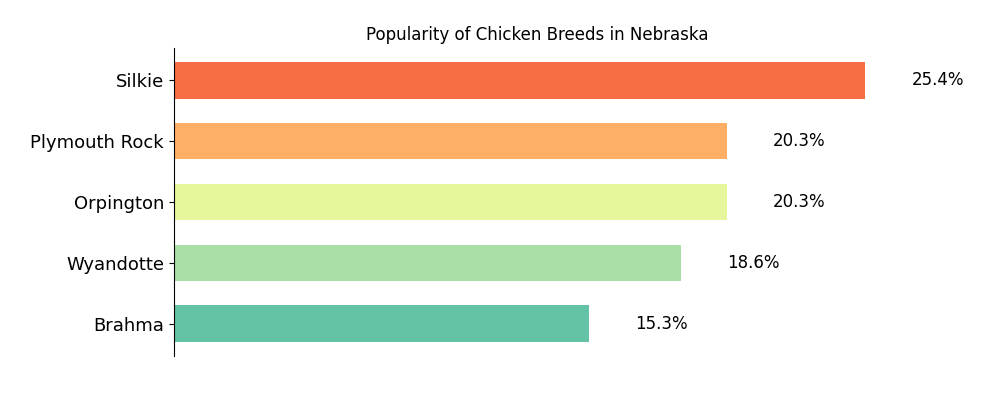
While Silkies enjoy widespread popularity, the Brahma breed stands out as the most preferred in North Platte. The gentle giant also garners significant attention in Lincoln. There seems to be a regional inclination towards larger, robust breeds within certain Nebraska communities.
Orpingtons and Wyandottes find a special place in Omaha. While their bodies are built very much alike, the Orpingtons are mostly popular in the buff variation, while the Silver Laced is the most popular Wyandotte, admired for its scalloped plumage.
The Plymouth Rock – especially the barred rock – holds a strong presence in the Lincoln & Hastings-Kearney area. The barred rock is a very reliable, easy-to-keep chicken. It’s hardy and provides around 200 large brown eggs every year.
Overall, Nebraska’s chicken-keeping scene is a blend of ornamental charm and utilitarian value.
Nevada
The cute, fluffy Silkies are by far the most-searched-for chicken breed in Nevada. They are particularly capturing the hearts of residents in Reno and Las Vegas, known for their vibrant nightlife and casino culture.
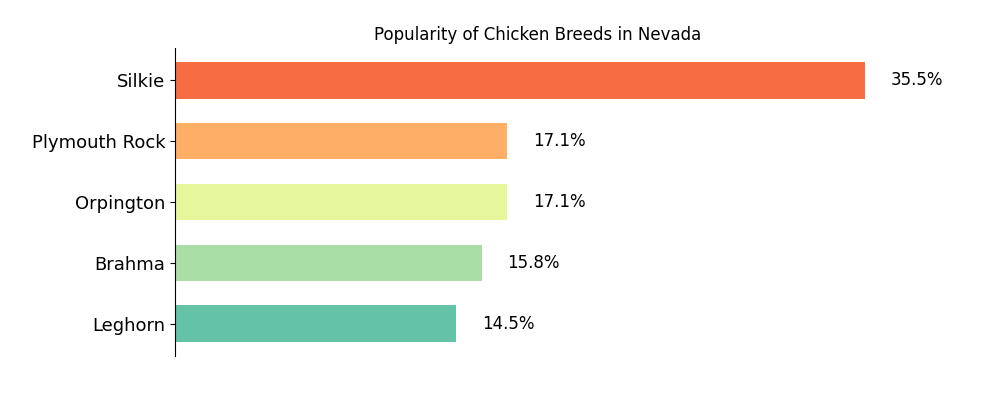
Second on the list is the Plymouth Rock, a reliable dual-purpose breed that provides both meat and eggs to the table. It’s a practical choice for the varied climates of Nevada, from its desert landscapes to urban backyards.
Orpingtons, particularly the Buff Orpington, have carved out a notable niche in Reno. They are beautiful, easy to care for and lay over 250 eggs annually.
Meanwhile, in Las Vegas and Paradise, the giant-but-gentle Brahmas enjoy a special popularity. After all, Brahmas are the king of poultry and lay up to 300 large brown eggs per year.
The popular egg-laying Leghorns round the top 5. Based on the search data, they seem to gain an extra nod due to the influence of the Warner Bros character Foghorn Leghorn, reflecting Nevada’s proximity to California’s entertainment world.
New Hampshire
The New Hampshire Red, an American breed developed in the early twentieth century within the state itself, leads the popularity chart in New Hampshire. It symbolizes local agricultural prowess and is specifically tailored to the regional climate and farming needs.
Its popularity in New Hampshire, as well as in neighboring Maine, reflects a shared New England poultry heritage. There are no other states where the New Hampshire Red made it into the top 5.
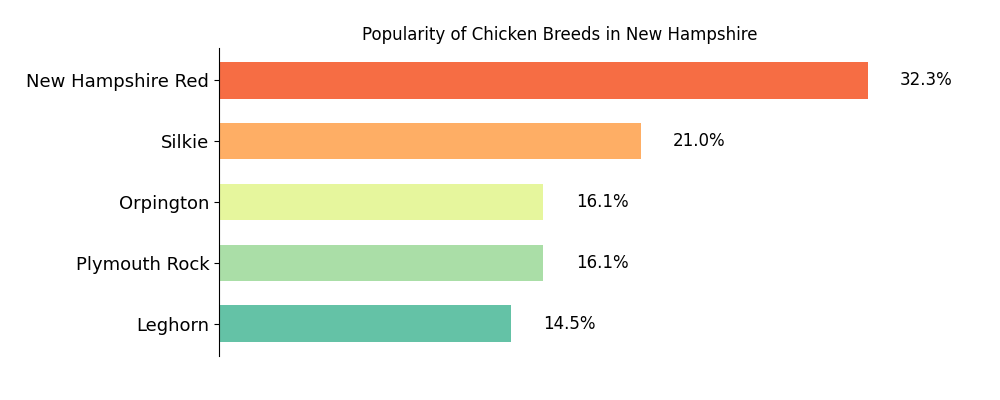
Following the New Hampshire Red are the Silkies. This all-popular pet chicken is widely appreciated for its unique fluffy appearance and friendly nature. New Hampshire is one of the only states where the Silkie is not on top of the chart.
Next on the list are Orpingtons and Plymouth Rocks, each holding their own among New Hampshire’s chicken enthusiasts, reflecting the state’s balance between aesthetics and utility.
The Plymouth Rock, another American breed with roots in the nearby state of Massachusetts, is a hardy breed that lays over 200 eggs per year. Its resilience to cold and easy management aligns well with New Hampshire’s climate and poultry-keeping traditions.
The Leghorn takes the fifth place on the list. It’s an all-time favorite egg layer in the US that lays over 300 eggs annually.
Interestingly, the Rhode Island Red, despite its proximity and similar origins, ranks just behind the Leghorn and did not make it into the top five in New Hampshire. The data suggests that the people in New Hampshire prefer the New Hampshire Red over the very similar Rhode Island Red, a breed exclusively used to create the New Hampshire Red.
New Jersey
In New Jersey, the fluffy Silkie is the most popular chicken breed. Silkies are especially searched for in Pitman, a borough known for its small-town charm in Gloucester County.
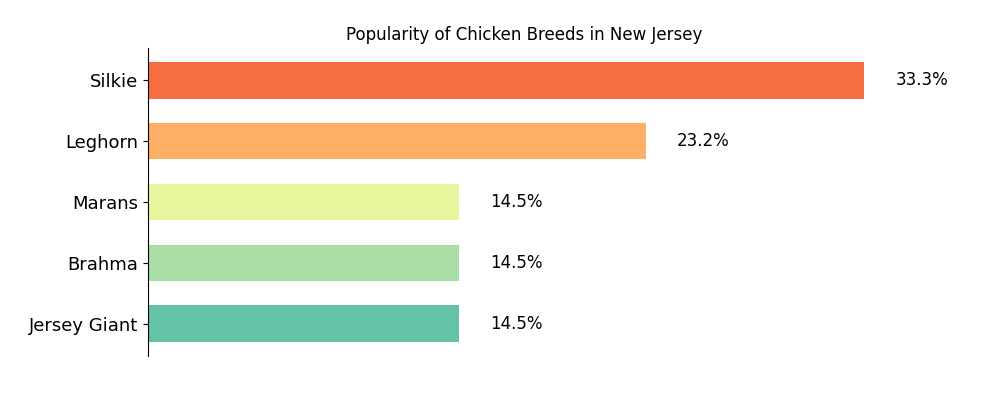
The white Leghorn comes in second. Leghorn hens lay 300 eggs annually and are a practical poultry-keeping approach. The first two places in the top 5 show New Jersey’s balance between productivity (Leghorn) and the aesthetic qualities of chickens (Silkies).
Marans, Brahmas, and the Jersey Giant share the third place, each with their own following.
The Jersey Giant, in particular, holds a special place as a breed that originated in Burlington County. As one of the heaviest chicken breeds, it was initially developed as an alternative to turkey. The large size and good egg-laying ability make the Jersey Giant a point of local pride.
The Marans chicken originates from the town of Marans, France (that’s why it’s always written with an s). They are an all-time popular beginner-friendly breed. Hens lay around 200 dark chocolate-brown eggs yearly.
New Jersey has a soft spot for gigantic chickens, with the enormous Jersey Giant roosters tipping the scales at 13 pounds, while a 10-pound Brahma rooster stands impressively in its own right.
Brahmas are especially sought after in Hopewell Township and Egg Harbor Township, possibly due to these areas’ more spacious and rural settings. However, there is also an increased popularity in Jackson, Evesham Township, and Paterson despite more varied urban and suburban landscapes.
New Mexico
The cute, fluffy Silkie is the most popular chicken breed in New Mexico. They are especially searched for in Albuquerque, the state’s largest city and economic hub. The Silkie’s fluffy appearance and friendly nature seem to resonate with the city’s creative spirit.
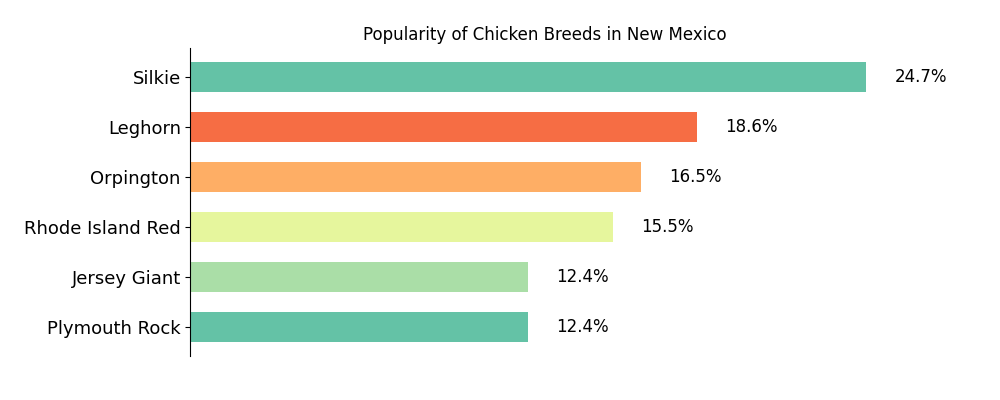
Second on the list is the white Leghorn, known for its amazing egg-laying capabilities. It’s a hardy breed that starts laying early and can bring over 300 eggs to the table in a single year.
Orpingtons, particularly the Buff variety, are also highly favored. The data for 2023 shows an emerging interest in the Lavender Orpington in New Mexico, showcasing a preference for both traditional and novel poultry breeds among the city’s chicken fans.
Rhode Island Reds, hardy chickens, and great layers hold their own in the lineup, aligning with the practical needs of urban poultry keepers in a bustling city.
Jersey Giants and Plymouth Rocks, each with their own following, round out the top choices. The Jersey Giants, known for their extremely large roosters, and Plymouth Rocks, popular for their dual-purpose qualities, reflect a blend of urban lifestyle with a nod to traditional farming roots.
New York
In New York, the fluffy Silkie is the most popular chicken breed. Their popularity peaks in Lakeland, a hamlet in Onondaga County, despite the lesser search frequency in nearby metro areas like Syracuse. In general, Silkies are the most popular in Utica, Elmira, and the New York metropolitan area.
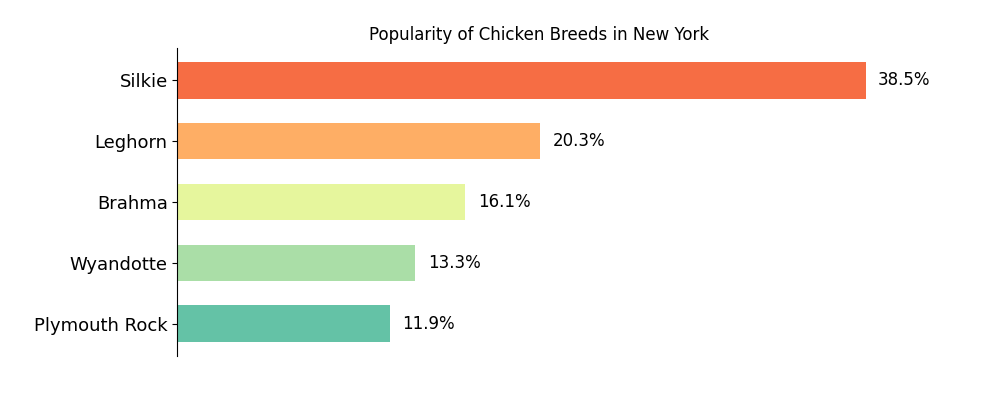
The Leghorns, known for their impressive egg-laying abilities, come in second. They show the practical needs of both urban and rural chicken keepers in the state.
Brahmas, with their majestic stature and gentle nature, are especially popular in Saratoga Springs and Rome, indicating regional preferences for larger, robust breeds within certain New York communities.
Wyandottes and Plymouth Rocks also have a significant presence. The former, with their amazing plumage and hardiness, and the latter, known for their dual-purpose utility. Both are great egg-layers, with hens laying over 200 eggs per year.
Interestingly, despite its proximity to Rhode Island, the Rhode Island Red – well-known for its robustness and egg-laying – surprisingly did not make it into New York’s top chicken breed list.
New York’s vibrant poultry scene is further enriched by its many poultry shows and fairs, which are more numerous than in other states. The most well-known one is the prestigious New York State Fair. Scheduled for late summer 2024, this event is a highlight for poultry enthusiasts, featuring a wide array of breeds and offering significant recognition.
North Carolina
In North Carolina, the fluffy Silkie is the most popular chicken breed. It is particularly favored in Wilmington and shows peak interest during springtime. The Silkie is the least popular in Greensboro High Point, where it receives the fewest searches.
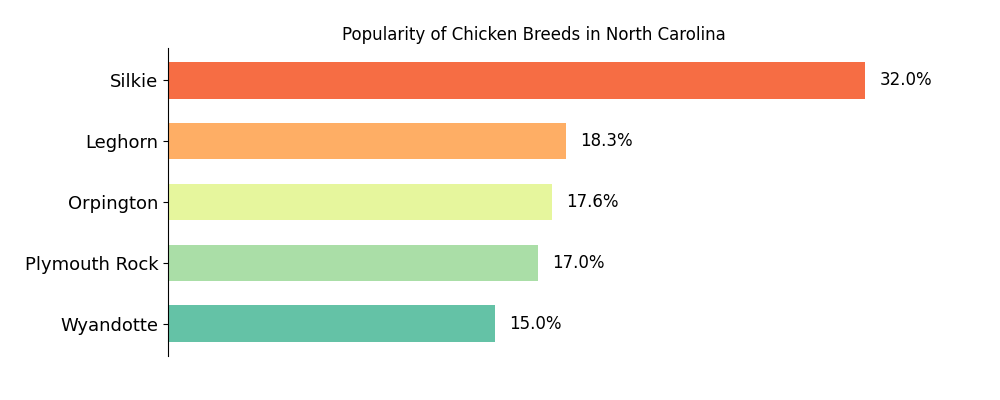
The Leghorn, known for its impressive egg-laying capabilities, takes the second spot. It is particularly popular in Indian Trail, a suburban town in Union County.
Third on the list is the Orpington, with its large round body and rich plumage. They are the most sought-after in Charlotte. The most popular is the Buff Orpington, but the lavender color variety has been gaining more and more searches lately.
Another breed that’s doing well in Charlotte is the similarly built Wyandotte. The Silver Laced Wyandotte is traditionally the most searched-for, but there is a growing interest in Golden Laced and Blue Laced varieties.
The fourth place on the list goes to the Plymouth Rock chickens, a robust layer of over 200 eggs per year. The Barred Rock is a practical choice for many poultry keepers in North Carolina but is especially popular in Asheville, where they are the second most searched-for breed after Silkies.
North Dakota
Brahmas are the most popular chicken breed in North Dakota, where temperatures can reach 50 below zero. With their large size and gentle nature, they are well-suited to the harsh winters, making them a sturdy choice. North Dakota is one of the few states where Silkies do not top the chart.
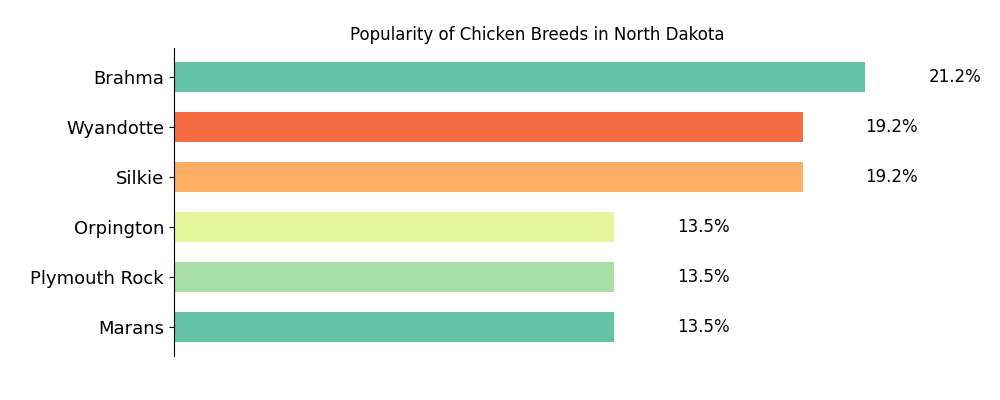
The cold-hardy Wyandottes, with their heavy plumage and pea comb, are second on the list of most searched-for breeds. Wyandottes were bred to withstand harsh American winters. Their low, broad rose combs are less likely to get frostbite, and their thick feathers keep them warm in winter. The hens lay around four large cream to brown eggs per week.
The Silkies, usually a national favorite, find a slightly lesser prominence in North Dakota due to the challenging northern climate. However, with their fluffy feathers, these pet chickens are still high on the list of popular breeds.
Orpingtons, Plymouth Rocks, and Marans share the fourth place in North Dakota. Orpingtons have a similar body composition as Wyandottes and are extremely cold-hardy. Their winter hardiness makes them the most popular breed in the neighboring state of Montana.
Plymouth Rock chickens are also extremely hardy and are among the most popular chicken breeds in the United States for practical poultry-keeping. Barred Plymouth Rocks are a dual-purpose breed, but most chicken owners keep them for the eggs. They are reliable layers, bringing around 200 eggs per year to the table, four eggs weekly.
Last but not least, the Marans, appreciated for their unique dark chocolate-brown eggs, add a distinctive touch to the North Dakotan poultry scene, similar to their popularity in cold Montana. Marans chickens are a fairly large dual-purpose breed kept for eggs and meat. They are heavier than pure egg layers like white leghorns.
Ohio
In Ohio, a state with a rich tradition in agriculture and poultry shows, the fluffy Silkie leads as the most searched-for chicken breed. In Steubenville, Silkies share the top spot with Plymouth Rocks. And despite being the least searched for in Dayton, they are still the most popular breed in that area.
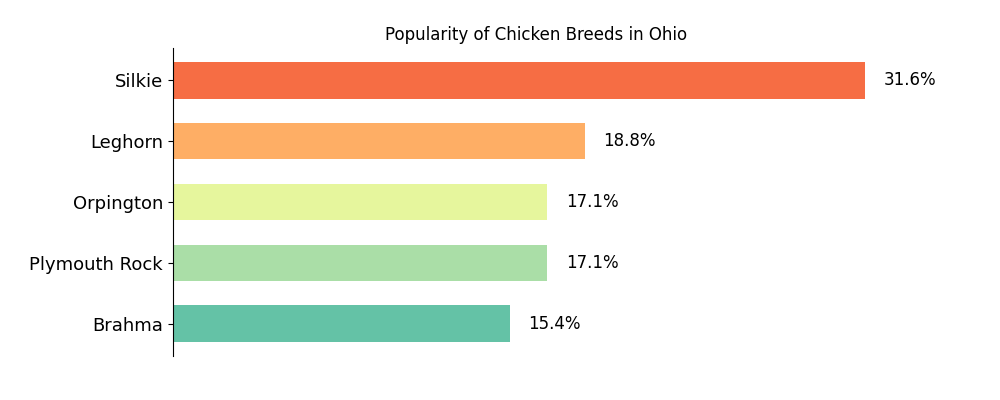
The Leghorn takes the second spot, favored for its exceptional egg-laying ability, laying over 300 eggs annually. This breed’s popularity underscores Ohio’s appreciation for efficient and productive poultry.
Orpingtons, particularly sought after in Columbus, follow closely. Their appeal lies in their plush plumage and gentle temperament, making them a well-rounded choice for both eggs and meat.
Brahmas, with their majestic stature and calm demeanor, are notably popular in Marion, Pataskala, and Wilmington. These gentle giants are well-suited for Ohio’s varying climates and backyards, offering both ornamental appeal and practicality. Brahma hens can lay 150 to 300 eggs yearly, depending on the strain.
Meyer Hatchery in Ohio further fuels the state’s chicken-keeping enthusiasm. Known for its diverse breed offerings and resources for backyard chicken keepers, the hatchery has been instrumental in popularizing the hobby across Ohio.
Ohio’s chicken-keeping culture is further enriched by a vibrant calendar of poultry shows and county fairs. These events, like the esteemed Ohio National Poultry Show in November and the Tri-State Poultry Association Show, temporarily relocated to Ohio, draw chicken fans from various regions.
Oklahoma
The fluffy Silkie chicken is the most searched-for chicken breed in Oklahoma. They are especially popular in Cole and surrounding areas. Their fluffy appearance and friendly demeanor make them the clear favorite among Oklahoma’s chicken enthusiasts.
There are many hatcheries and hobby breeders of Silkies in Oklahoma. Although Cottonwood Filly has ceased breeding Silkies, there are numerous other places where you can acquire Silkies, such as Okie Chicks N Eggs and Bent Arrow Silkies.
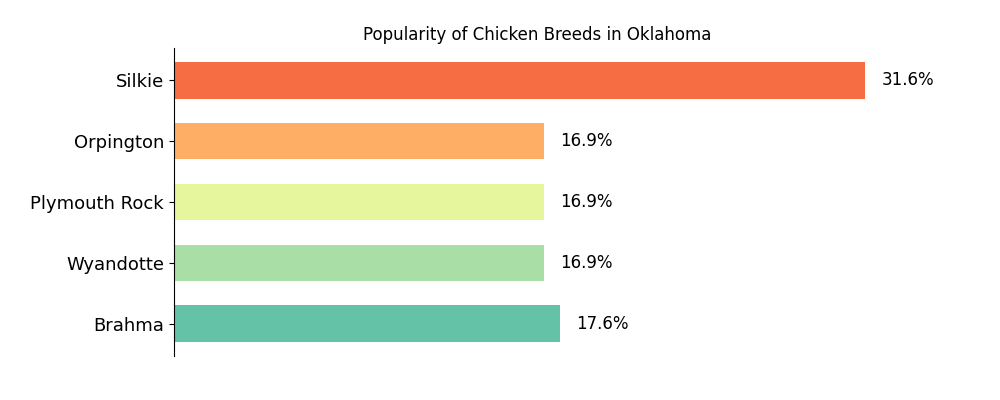
Orpingtons, Plymouth Rocks, Wyandottes, and Brahmas share a close contest for the next spots. Orpingtons, especially popular in Lawton, are favored for their amazing plumage and docile nature.
Plymouth Rocks, known for their dual-purpose utility, find their stronghold in Tuttle and Tulsa, reflecting their adaptability to both urban and rural settings.
Wyandottes, admired for their striking feathers and hardiness, are most favored in Tuttle and Oklahoma City. Their resilience makes it well-suited to Oklahoma’s varying climate conditions.
Brahmas, with their impressive size and serene temperament, enjoy particular popularity in Durant, Muskogee, and Sapulpa, with notable interest also in Goldsby, Norman, and Midwest City. The increasing interest in the Buff Brahma variety highlights a growing trend towards ornamental yet practical breeds in Oklahoma.
Oregon
In Oregon, the fluffy Silkie is by far the most searched-for chicken breed. Particularly popular in Medford and Klamath Falls in southern Oregon, Silkies also garner substantial interest in Eugene, near the coast, and Bend in central Oregon. In fact, nearly half of all chicken breed searches in Bend are Silkie-related.
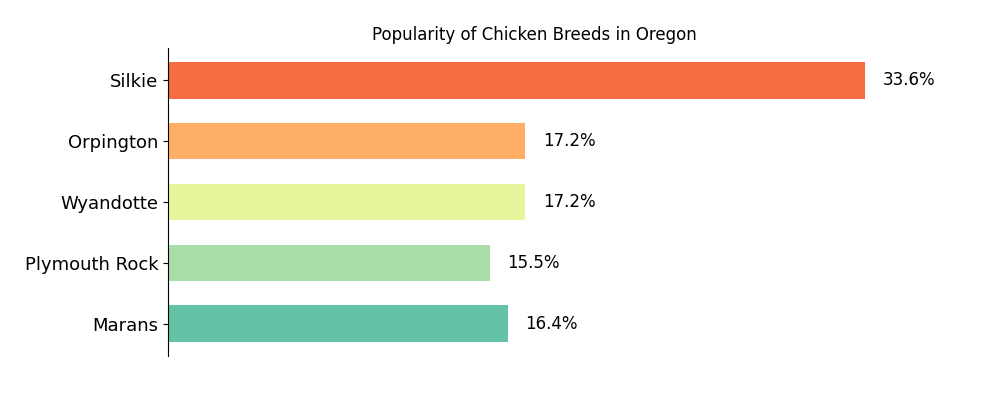
Orpingtons, including both the traditional Buff and increasingly popular Lavender varieties, are tied for second place with the Wandottes. Orpington hens are heavy with soft plumage and lay around 250 large brown eggs yearly. They are particularly favored in Eugene, where they rank second after Silkies, reflecting a preference for their rich plumage and friendly nature.
Next on the list are the very similar built and immer popular rose comb Wyandottes. The hens have amazing round bodies and lay roughly 200 eggs yearly. Wyandottes come in many, many varieties, but the Silver Laced Wyandotte is clearly the most popular in Oregon.
Plymouth Rocks are a popular, practical, dual-purpose breed for eggs and meat. They suit Oregon’s varied climate and lifestyles. Most chicken fans keep them for the eggs. They are reliable layers, bringing around 200 eggs per year to the table; that’s four eggs weekly.
Marans, famous for their dark chocolate-brown eggs, are notably the third most popular breed in Eugene. Like the other breeds in the list (apart from Silkies), Marans chickens are also rather large chickens. They’re a dual-purpose breed that is kept both for eggs and meat, and they are heavier than pure egg layers like white leghorns.
Pennsylvania
In Pennsylvania, the fluffy Silkies are the most searched-for chicken breed. They are particularly popular in Erie, where more than half of the chicken breed searches are for Silkies. Their distinctive fluffy appearance and friendly nature make them a top choice among Pennsylvania’s poultry enthusiasts.
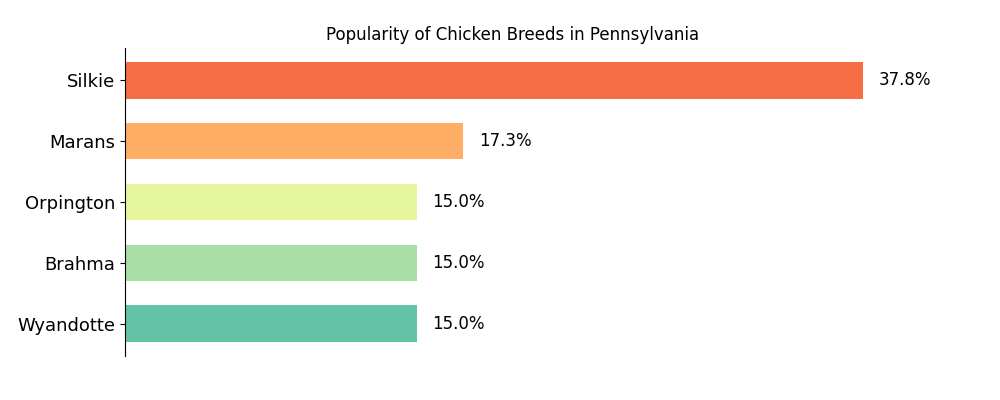
The other breeds in the top 5, following the Silkies, are all larger egg-laying breeds. The Marans chickens, known for their dark chocolate-brown eggs, hold the second spot. They’re a dual-purpose breed, kept for eggs and meat, and heavier than pure egg layers like white leghorns.
Orpingtons, Brahmas, and Wyandottes share the third place. Orpingtons are popular due to their large bodies with rich plumage and gentle temperament. Orpington hens lay around 250 light brown eggs per year.
The Brahmas are the largest of the list. The roosters tip the scale at ten to twelve pounds, and the hens come in at eight to ten pounds. They are giant, stunning chickens with unique personalities, often called the king of poultry. Most Brahma chickens sold nowadays at hatcheries will lay around 200-250 eggs yearly. In Pennsylvania, Brahma chickens are especially searched for in Mechanicsburg.
Wyandottes, with equal popularity, get the most searches from Johnstown and Altoona. Their hardiness and amazing plumage make them a practical and attractive choice for Pennsylvania’s varied climates and settings. The Silver Laced Wyandottes are the most popular color variety in Pennsylvania.
However, the poultry scene in Pennsylvania has faced challenges. As of June 2022, the Pennsylvania Department of Agriculture issued a quarantine order banning poultry exhibitions at county and local fairs. This order, still in effect in 2024, has put a halt to poultry shows, impacting the traditional avenues for showcasing and celebrating the diverse range of poultry breeds in the state.
Despite this setback, the interest in chicken breeds like the fluffy Silkies and robust Brahmas continues.
Rhode Island
The Rhode Island Red emerges as the most popular chicken breed in Rhode Island, a state with a rich poultry heritage.
It is one of the few states where the fluffy Silkie, a national favorite, is not the most popular breed. Instead, the Rhode Island Red, developed in Rhode Island and Massachusetts, takes the top spot.
The Rhode Island Red is not only the state bird but also a staple in backyard flocks, as the hens lay 200–300 brown eggs annually.
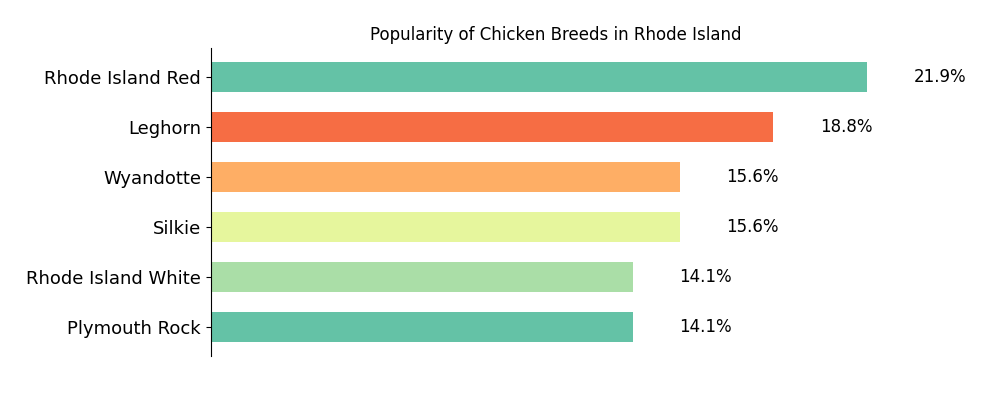
The Leghorn follows. It’s an all-time favorite, as the hens can lay over 300 eggs annually. Fun fact: the Rhode Island Red was once created by cross-breeding Oriental birds like the Malay with Italian Leghorns.
Wyandottes and Silkies, each with their own following, are also popular. Silkies, particularly favored in Providence, are known for their distinctive fluffy appearance and friendly nature. In most states, they are by far the most-searched-for chicken breed, so it’s rare to see them in the third spot.
With their large, round bodies, Wyandottes lay around 200 eggs yearly. The Silver Laced Wyandottes are the most popular in Rhode Island.
The Rhode Island White, a breed originating in Rhode Island and distinct from the Rhode Island Red, holds a special place in the state’s top five. The hens lay 200-250 large (to jumbo) brown eggs per year, and they keep laying in the winter. It’s the only state where the Rode Island White made it into the top five.
The Plymouth Rock, created in Massachusetts, shares the fifth place with the Rhode Island White. It’s a hardy dual-purpose breed, popular for both eggs and meat. That said, most people keep Barred Rocks for their eggs. They are reliable layers, bringing around 200 eggs per year to the table, or four eggs weekly.
South Carolina
The fluffy Silkie is the most searched-for chicken breed in South Carolina. With their unique fluffy feathers and friendly nature, Silkies are uniformly favored across the state.
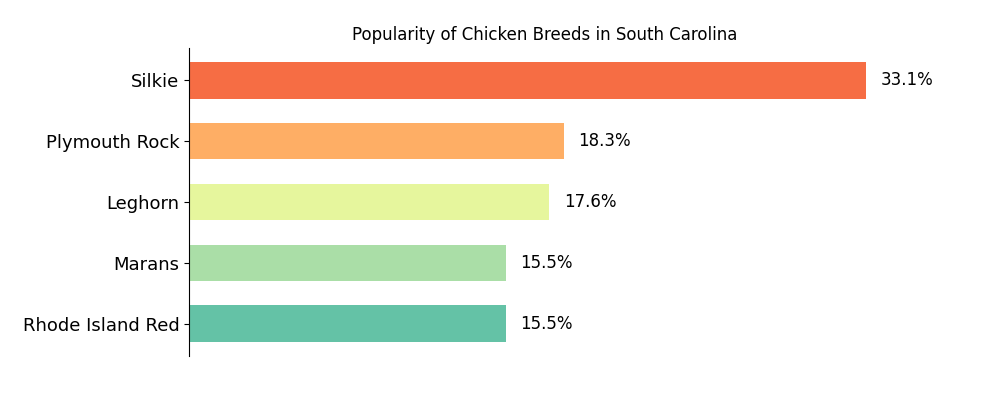
Following the Silkies, Plymouth Rocks and Leghorns take the second and third place, respectively. The Barred Rock is a popular, hardy, dual-purpose chicken breed used for both eggs and meat. Most people keep Barred Rocks for their eggs. The hens lay about four eggs every week.
The Leghorn hens are real egg-laying machines; some lay over 300 eggs in a year. Both Plymouth Rocks and Leghorns are practical choices for those prioritizing productivity.
Marans and Rhode Island Reds, each with a significant following, round out the top five. The Marans are cherished for their rich, chocolate-brown eggs.
The Rhode Island Red, particularly popular in Columbia and Charleston, is also known for its robust egg-laying abilities, which suggests a statewide focus on breeds that excel in egg production.
South Dakota
In South Dakota, the Wyandotte is the most searched-for chicken breed. With their heavy plumage, they are well suited to the state’s climate, which can include cold winters. The popularity of the Wyandottes in South Dakota is mirrored by their high ranking in neighboring North Dakota.
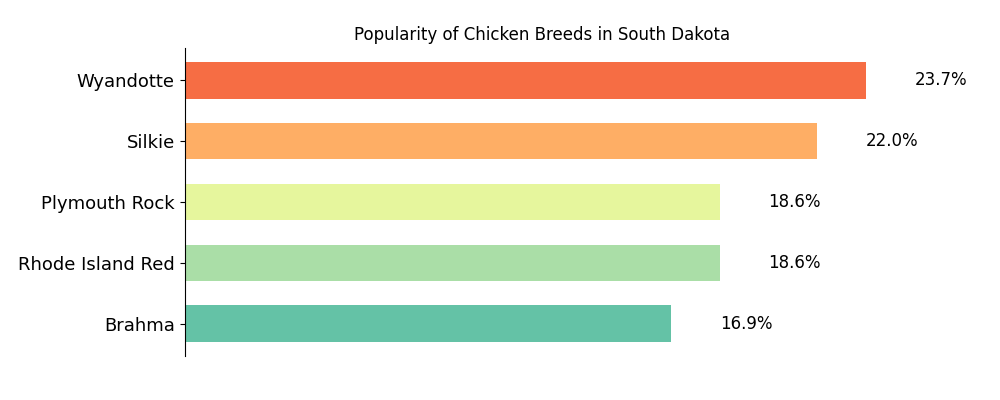
Silkies, usually a top choice nationwide, take a slightly lesser prominence in South Dakota, marking it as one of the few states where they are not the most searched-for breed. Nonetheless, their unique fluffy appearance and friendly nature still make them a beloved choice among the state’s chicken enthusiasts.
Plymouth Rocks and Rhode Island Reds, each with their practical and dual-purpose qualities, are tied for the third place. Both are hardy breeds and excellent egg-layers, laying over 200 eggs annually, making them a practical choice for poultry keeping.
Brahmas are particularly popular in the western part of the state, including the Rapid City metro area. They stand out for their majestic size: the roosters tip the scale at ten to twelve pounds, and the hens come in at eight to ten pounds. They are giant, gentle, stunning chickens with unique personalities, often called the king of poultry.
In South Dakota, a state with a rich Indigenous history, including the Cheyenne and Sioux, the introduction and adoption of chicken breeds like the Wyandotte and Brahma reflect a blend of modern agricultural practices with traditional land stewardship.
Tennessee
In Tennessee, the Silkie is the most frequently searched-for chicken breed, with nearly twice as many searches as any other breed. It’s particularly popular in Jackson, where over 60% of chicken breed searches are for Silkies. There is also a rising interest in the Black Silkie variety, with a 50% increase in searches.
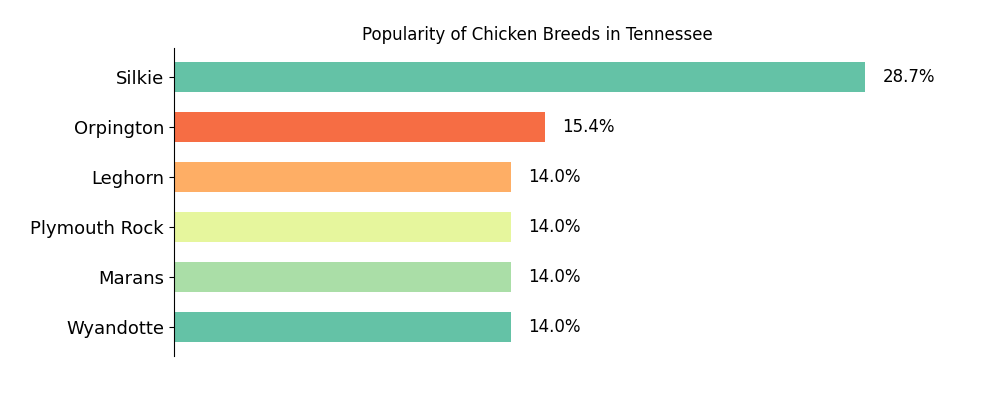
Following the Silkies, Orpingtons, Leghorns, Plymouth Rocks, Marans, and Wyandottes share a close contest in popularity. Most chicken breed searches in Tennessee originate from the Tri-Cities region, with Chattanooga also showing significant interest.
Orpingtons come in second place. The Orpington hens are heavy with soft plumage and lay around 250 large brown eggs yearly. The most popular is the Buff Orpington, but the lavender color variety has been gaining more and more searches lately in Tennessee.
Leghorns, particularly favored in Jackson, stand out for their exceptional egg-laying capabilities, producing over 300 eggs annually. Similarly, Plymouth Rocks – popular for both eggs and meat – are another practical choice for poultry keepers.
Marans are popular for their chocolate-brown eggs. They lay up to 200 large dark brown eggs yearly, similar to the rose-combed Wyandottes – the last ones to share the third spot. Especially the Silver Laced Wyandottes are popular in Tennessee.
Tennessee is unique for its lack of clear dominance by any single breed, except for the widely beloved Silkies. There is an observable growing interest in a diverse array of chicken breeds and varieties in Tennessee, including Polish chickens, Ameraucanas, Speckled Sussex, Chocolate Orpingtons, Buff Orpingtons, Black Australorps, and Black Copper Marans.
This widespread curiosity across the state is possibly influenced by the proximity of major hatcheries like Cackle Hatchery in Missouri and Hoover’s Hatchery in Iowa, which offer a wide variety of breeds and contribute to the growing enthusiasm for different chicken types.
Texas
The Silkie chicken breed is the standout favorite in Texas. Particularly popular in El Paso, Floresville city, Sherman metro, and Wichita Falls, Silkies are cherished for their unique fluffy feathers and friendly personalities, capturing 64% of chicken-breed searches in El Paso.
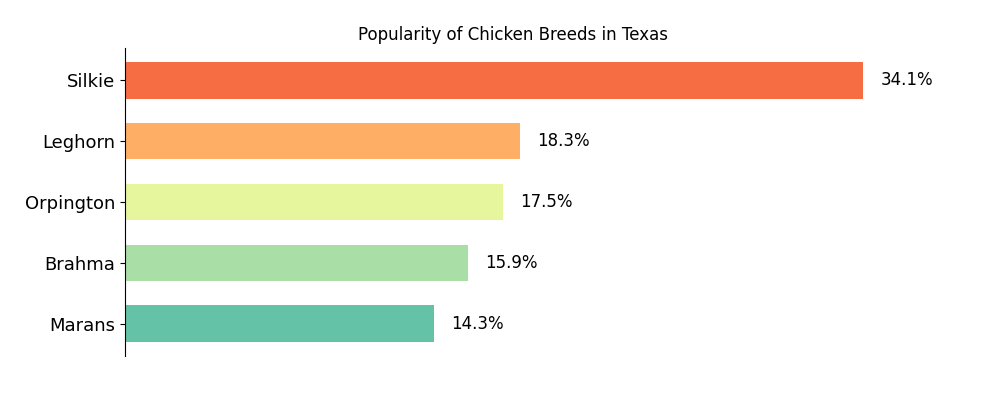
Leghorns, known for their impressive egg-laying capacity, are the second most popular, especially in Midland, Sweetwater, and Abilene. Their efficiency and hardiness make them a practical choice, well-suited to Texas’s diverse agricultural settings.
Orpingtons are the close third in the list, popular for their rich plumage and magnificent bodies. They are particularly popular in Sherman, Longview, Port Arthur, Wichita Falls, Abilene, and Sweetwater. The Buff Orpington variety is the most popular, with Lavender Orpingtons gaining traction.
Giant Brahmas – the king of poultry – are especially searched for in southern regions, and they are the most popular chicken breed in Victoria. The gentle giants are the most searched-for in Todd Mission, Cleburne, and Boerne (extending to Canyon Lake and San Antonio). But also to gather significant interest in North Richland Hills, Tom Bean, Wake Village, and Nacogdoches.
The San Antonio Brahmas football team might influence the breed’s popularity in the San Antonio region, though this could also be a case of search engines misinterpreting the keyword.
The Marans chickens round the top 5. They are rather large, calm, hardy birds, favored for their large dark chocolate-brown eggs, most sought after in Sherman.
Utah
The fluffy Silkie chicken emerges as the most popular breed in Utah, especially in Park City.
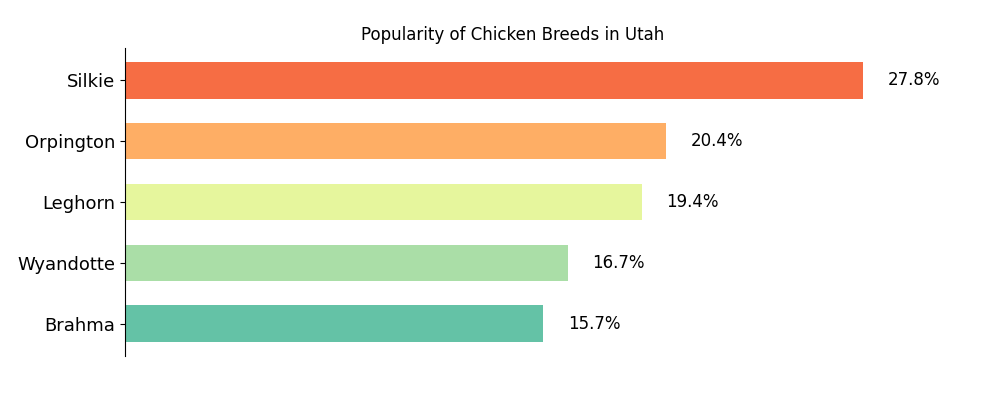
Second on the list is the Orpginton, a beautiful heavy egg layer providing 250 light brown eggs annually. Orpingtons are particularly searched for in Coalville and Salt Lake City, favorited for their heavy plumage and docile temperament. The Buff Orpington variety is by far the most popular.
The white Leghorn is the close third in the list. It’s a practical choice for many poultry keepers in Utah’s diverse environments, ranging from mountains to deserts. Leghorn hens start laying early and can lay over 300 white eggs in a year. White Leghorns are especially popular in Salt Lake City, where they’re most sought after for their efficiency and hardiness.
Wyandottes, most popular in Salt Lake City, are admired for their amazing plumage and hardiness. The Silver Laced Wyandotte is the most favored, though there’s growing interest in the Blue Laced Red Wyandotte in Utah, showcasing a preference for both beauty and adaptability.
Brahmas complete the list. They are gentle giants, known for their impressive size and calm nature – sometimes called the King of Poultry. They are especially sought after in Cottonwood Heights, West Jordan, and surrounding areas like Ogden, Kaysville, Lehi, and Coalville. There appears to be some rising interest in the southern part of the state, especially in St. George.
Despite not making it to the top list, the Rhode Island Red is gaining much popularity in Utah in 2023, reflecting a growing interest in robust and productive breeds.
Vermont
In Vermont, known for its picturesque New England landscapes and cold winters, the chicken breed preferences reflect a mix of aesthetics and practicality without a clear dominant breed. The popularity of various breeds fluctuates throughout the year, indicating diverse interests among the state’s poultry keepers.
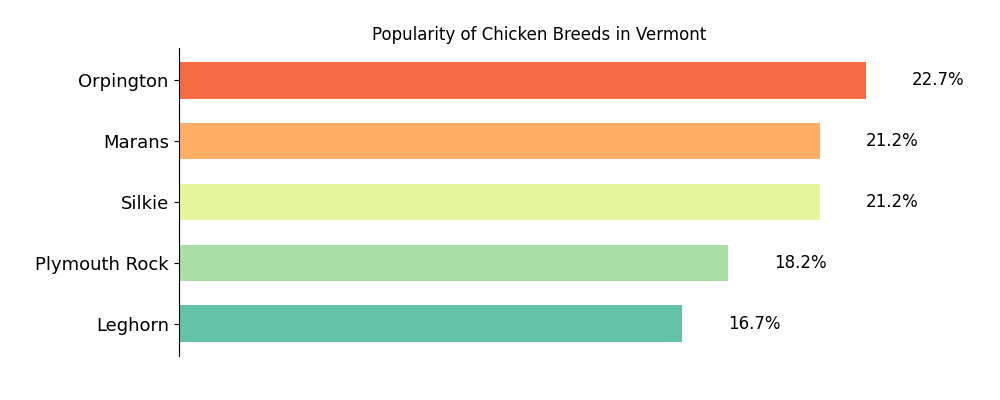
Orpingtons, particularly suited to Vermont’s climate, lead the preference in 2023. These chickens are known for their heavy plumage and gentle nature, making them ideal for the cold winters. Most Orpington hens will keep laying during the winter, making them a practical choice for many chicken keepers.
The second most popular breed in Vermont is the Marans, which carries a nod to its French origins. Hailing from the town of Marans, France, this breed is known for its deep, chocolate-brown eggs. The hens are rather large chickens that can lay 200 dark brown eggs annually.
The Silkies, an all-time national favorite, also makes it to the top of the list. They are popular pet chickens with a fluffy appearance and friendly demeanor, especially searched for in Burlington.
Next on the list are the reliable barred Plymouth Rocks, used for both eggs and meat. They are a very cold-hardy breed, well-suited to Vermont’s varied environments.
Leghorns, though less prominent in Vermont, are still valued for their prolific egg-laying capabilities. Although they are a Mediterranean breed, they are still very cold-hardy.
Interestingly, despite Vermont’s proximity to New Hampshire, the New Hampshire Red, popular in neighboring Maine, doesn’t garner much attention in Vermont. This suggests unique local preferences that differ even among neighboring states.
In the past two decades, backyard chicken keeping has witnessed a noticeable surge in popularity across Vermont, a trend affirmed by municipal officials. While the state of Vermont does not maintain official statistics, the uptick in searches on Google and our site signals a clear and growing trend in popularity.
Notably, Vermont is also home to Jenn Megyesi, who resides in Royalton. She is the author of “The Joy of Keeping Chickens” and numerous other informative books popularizing chicken keeping and homesteading.
Virginia
The fluffy Silkie is the most searched-for chicken breed in Virginia, a state with diverse landscapes ranging from the Appalachian Mountains to the Atlantic coast. The pet chicken is popular for its fluffy feathers and friendly nature. They are particularly favored in Harrisonburg, where half of the chicken breed searches are for Silkies.
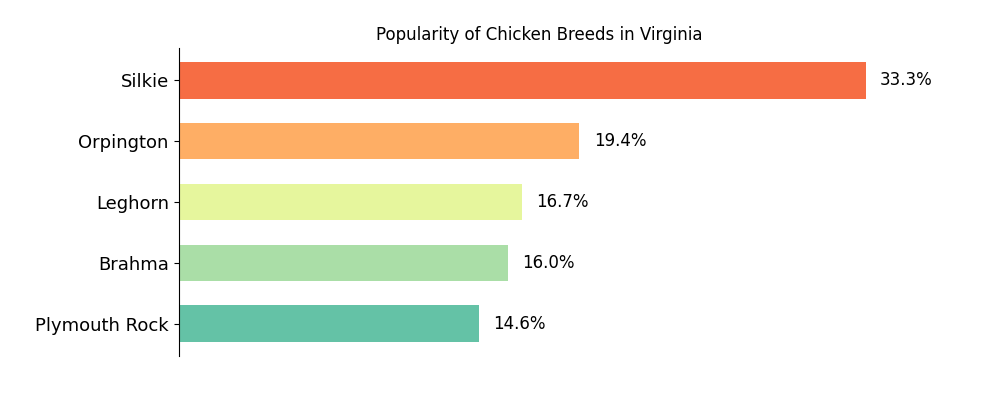
Second on the list are Orpingtons, a popular choice for both rural and urban settings. These large chickens have a round body with heavy plumage and a gentle disposition, suitable for Virginia’s varied climates.
Third are the white Leghorns, one of the top egg layers in the world. They start laying early, and some lay more than 300 eggs yearly. Leghorns are especially popular in Bristow and cities around the Chesapeake area, including Norfolk, Virginia Beach, and Newport News.
Following closely are the giant-but-gentle Brahmas, often called the King of Poultry. They have a strong following in Bristol, close to the Appalachian Mountains, and Aquia Harbour, in the eastern part of Virginia. There is also a growing interest in areas like Chester, Woodlake, Suffolk, Chesapeake, Virginia Beach, Roanoke, and Lynchburg. Their popularity across both eastern and western regions of Virginia reflects their versatility and appeal in different settings.
Last but not least are the barred Plymouth Rocks, which are among the most popular dual-purpose chicken breeds in the United States. Barred Rocks are very hardy chickens, and their hens can provide about 200 eggs annually. Plymouth Rocks are especially popular in Roanoke and Charlottesville.
Washington
The fluffy Silkie chicken is the clear favorite in Washington. These pet chickens are particularly popular in Seattle and Tacoma, where 36% of chicken breed searches are from people searching for info on Silkies.
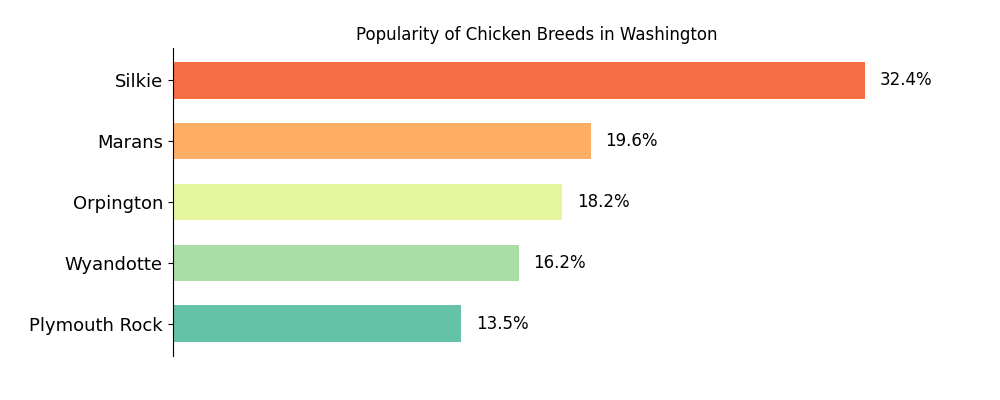
Marans chickens are quite surprisingly holding the second spot. They are increasingly sought after for their dark chocolate-brown eggs. Way more than in other states, there is a rising interest in Washington for several varieties, like Cuckoo Marans, Black Copper Marans, and even the rare Blue Copper Marans. We have no explanation for this rise in popularity apart from word of mouth within the local chicken-keeping community.
Orpingtons, especially popular in Spokane, are known for their rich plumage and friendly nature. The hens lay around 240 to 270 large light brown eggs per year. The Buff Orpington is the most favored, though Lavender Orpingtons are gaining popularity.
A close third is the similarly built rose comb Wyandotte, popular for its beautiful feathers and hardiness. Wyandotte chickens are the most popular in Yakima and in the Tri-Cities area along the Columbia River, with most searches coming from Pasco, Richland, and Kennewick.
Yet again, people are searching for different color varieties, and a noticeable trend emerges in Washington. People actively seek various varieties of Wyandottes, including the Silver Laced Wyandottes, Golden Laced Wyandottes, Blue Wyandottes, and Blue Laced Wyandottes.
The barred Plymouth Rock is rounding the top 5. It’s an all-time practical dual-purpose breed popular for both meat and eggs and well-suited to Washington’s diverse agricultural settings.
Some breeds didn’t make the list but deserve a mention. The first one is the Brahma, a gentle giant that’s especially popular in Tumwater and Corbett. The Columbian Brahma variety is the most searched for in Washington.
The Australorp and Rhode Island Red, though not making the top list, also have a significant following, and their popularity is rising. The Australorp, which is most popular in Spokane, is in demand not only in its traditional black variety but also in the blue variant, confirming the emerging trend of people searching for non-standard color varieties in Washington.
West Virginia
The fluffy Silkies are the most searched-for chicken breed in West Virginia. These pet chickens are known for their unique fluffy feathers and friendly demeanor. They are especially popular in Charleston, the state’s capital city located at the confluence of the Elk and Kanawha rivers.
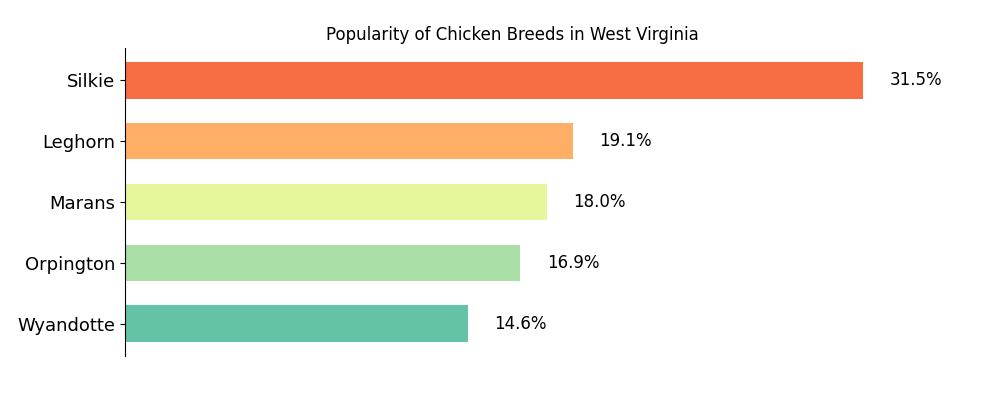
Second on the list are Leghorns, popular for their impressive egg-laying capacity, laying over 300 eggs per year. These hardy and efficient layers align well with West Virginia’s agricultural landscape and climate. The white Leghorn is especially popular in Bluefield and Beckley.
The Marans chickens take the third place. They are particularly favored in Clarksburg and Weston. Marans chickens are fairly large chickens, popular for their dark chocolate-brown eggs.
There seems to be a growing interest in the Cuckoo Marans variety in West Virginia. Their plumage, characterized by a dark barring pattern, resembles the popular Barred Plymouth Rock, which is another national favorite but not as prevalent in West Virginia.
Next on the list are the Orpingtons, with their rich plumage and round body. They are most popular in Clarksburg, Weston, and southern areas like Bluefield, Beckley, and Oak Hill. Orpington hens lay around 240 to 270 eggs per year.
The Wyandottes, with the Silver Laced Wyandotte being the most popular, take the last spot in the top 5. Wyandotte hens lay 200 eggs annually and tend to keep laying in the winter. Like the Orpingtons, they are cold-hardy, resilient chickens that are well-suited to the mountainous regions and changing weather of West Virginia.
Wisconsin
The fluffy Silkie chicken breed tops the popularity chart in Wisconsin. Silkies are adored for their unique fluffy feathers and friendly nature. They are particularly favored in Superior (along Lake Superior).
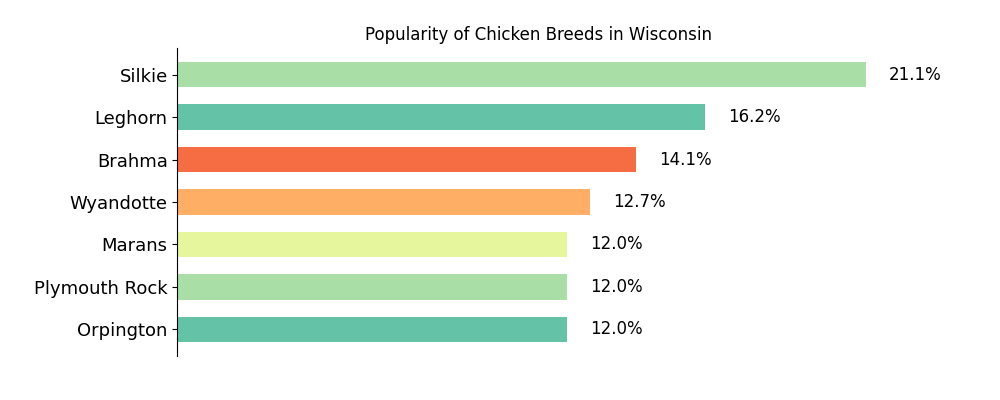
Second on the list is the white Leghorn, most popular in the Wausau-Rhinelander area of north-central Wisconsin. Leghorns are popular as the hens are hardy and can lay over 300 white eggs per year. These efficient layers are a practical choice for Wisconsin’s varied agricultural settings.
Next on the list is the giant-but-gentle Brahmas, often called the King of Poultry. Their hardiness makes them well-suited to Wisconsin’s colder climates and the diverse landscapes from the Great Lakes to lush farmlands. Brahma hens lay around 200 to 250 eggs yearly.
Next on the list are the beautiful and cold-hardy Wyandottes, bred especially to withstand cold American winters. Wyandottes are most popular in Madison, but there is also some notable interest in Milwaukee. The hens lay around four large brown eggs per week.
Three breeds are tied for the fifth place. Marans, particularly popular in Wausau, are famous for their dark chocolate-brown eggs. There is a rising interest in the Cuckoo Marans in Wisconsin. Their plumage, characterized by a dark barring pattern, resembles the popular Barred Plymouth Rock, a trait they share as they tie for fifth place in popularity.
Plymouth Rocks are another national favorite in the list, used for both eggs and meat. They are popular in Madison, just a 2-hour ride from Wausau, where the Cuckoo Marans is the most popular.
Last on this list are the Orpingtons, magnificent and easy-to-care-for chickens with rich plumage. They are especially popular in the Wausau-Rhinelander area and anywhere from La Crosse to Eau Claire. Like all the breeds on this list – except for Silkies – Orpingtons are prolific layers, producing 240-270 eggs per year.
Wyoming
Silkie chickens are the most searched-for chicken breed in Wyoming, known for its rugged landscapes, including the Rocky Mountains and vast plains. These pet chickens are known for their unique fluffy feathers and friendly nature. They are especially popular around Jackson near Idaho Falls.
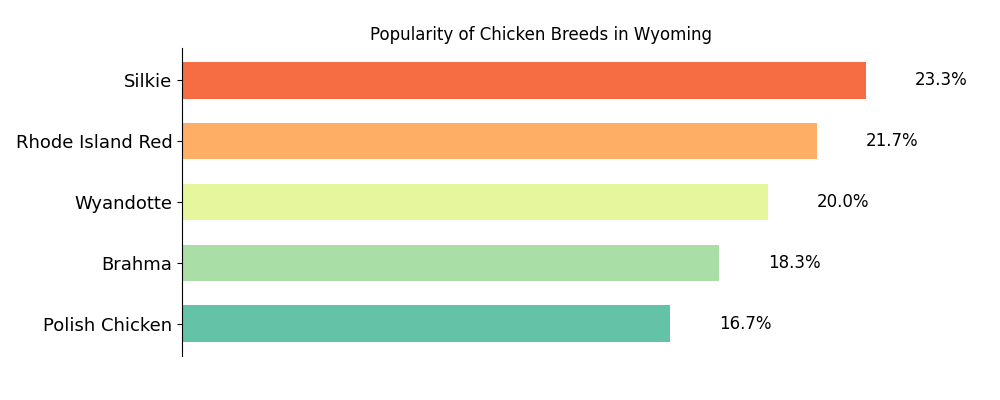
A close second on the list is the Rhode Island Red, a robust egg-layer and a practical choice well-suited to Wyoming’s varied environments. The Rhode Island Red is the most popular in the southwestern part of Wyoming, including cities and areas like Evanston, Rock Springs, and Green River.
Next on the list are the Wyandottes. With their round body and rich plumage, the hardy Wyandotte hens lay around four large brown eggs per week. They are most popular in northern Wyoming cities like Cody, Powell, Greybull, Lovell, Sheridan, and Buffalo. With their heavy feathering and small rose combs, they excel in Wyoming’s colder climate.
Brahmas come in fourth place on the list. These gentle giants, often called King of Poultry, have a strong following in the Gillette-Rapid City corridor. Their feathered feet and majestic presence make them a popular choice in Wyoming’s diverse landscapes.
Surprisingly, the Polish Chicken makes an appearance in the top five most popular breeds. Wyoming is one of the few states where the Polish make the list. Polish chickens are known for their distinctive crest of feathers, giving them their iconic look. They are particularly favored in the Rocky Mountain region and areas around Yellowstone National Park, including Cody, Dubois, and Jackson.
Continuing with the trend of distinctive breeds, the bearded Ameraucana, though not in the top five, enjoys significant popularity in Wyoming compared to other states. The Ameraucana is a relatively new APA-standard chicken breed popular for its blue eggs.
In summary, Wyoming’s chicken-keeping scene, influenced by its natural beauty and challenging climates, showcases a blend of ornamental charm and practical utility.
Top 10 Favorites: The Most Popular Chicken Breeds
With the numbers now behind us, let’s have a quick look at our beloved stars of backyards and barnyards across the nation. Use the links to navigate to the breed profile if you’re searching for more info. From the fluffy Silkie to the amazing Ameraucana, here are the most popular chicken breeds:
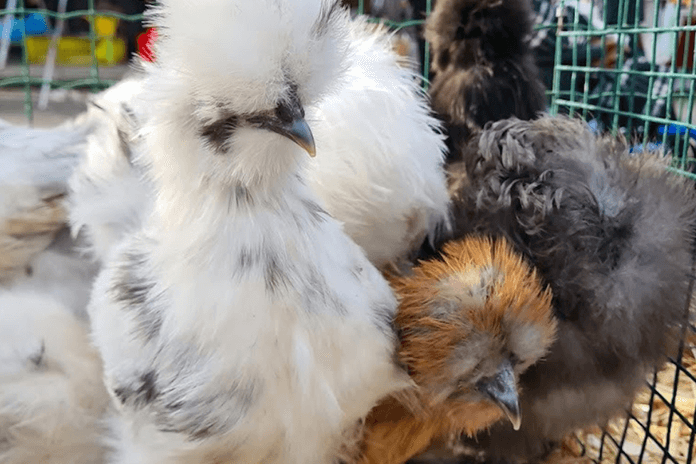
1. Silkies
Silkies are extremely popular pet chickens, especially with children. They have fluffy feathers, black skin, five toes, and blue earlobes and are just super cute. Silkies top the popularity list in 43 states and are favored nationwide.
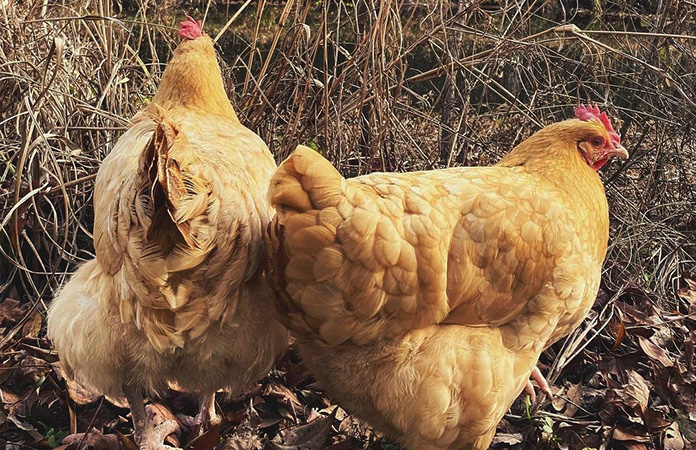
2. Orpington
Orpingtons are large, easy-to-care-for, dual-purpose chickens that lay 250 large light brown eggs annually. They reached the top 5 in 40 states and are leading in Montana and Vermont. The Buff Orpington is the most popular, but the Lavender Orpington is gaining popularity in some states.
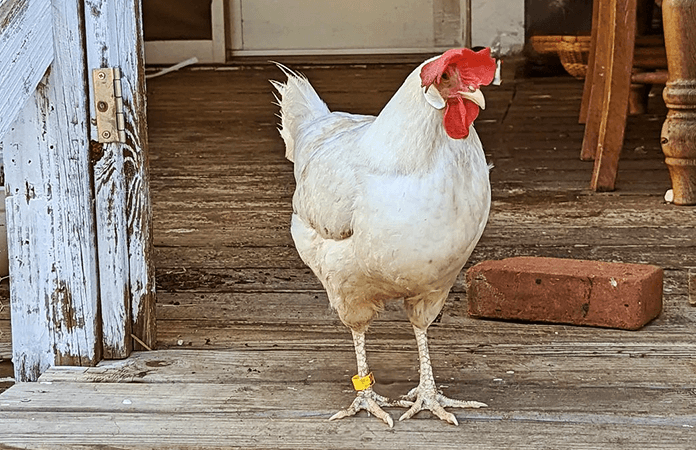
3. White Leghorn
Leghorns are a Mediterranean breed known for their hardiness and for laying over 300 large white eggs annually. They feature in the top 5 chicken breeds across 38 states and are a practical choice for many chicken keepers.
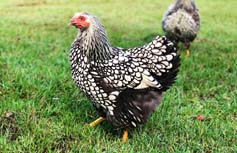
4. Wyandotte
Wyandottes, with their round bodies and a yearly yield of 200 large brown eggs, are favorites in 35 states, leading in South Dakota and Alaska. The Silver Laced variety is the most popular, though the Golden Laced and Blue Laced Red are gaining traction.
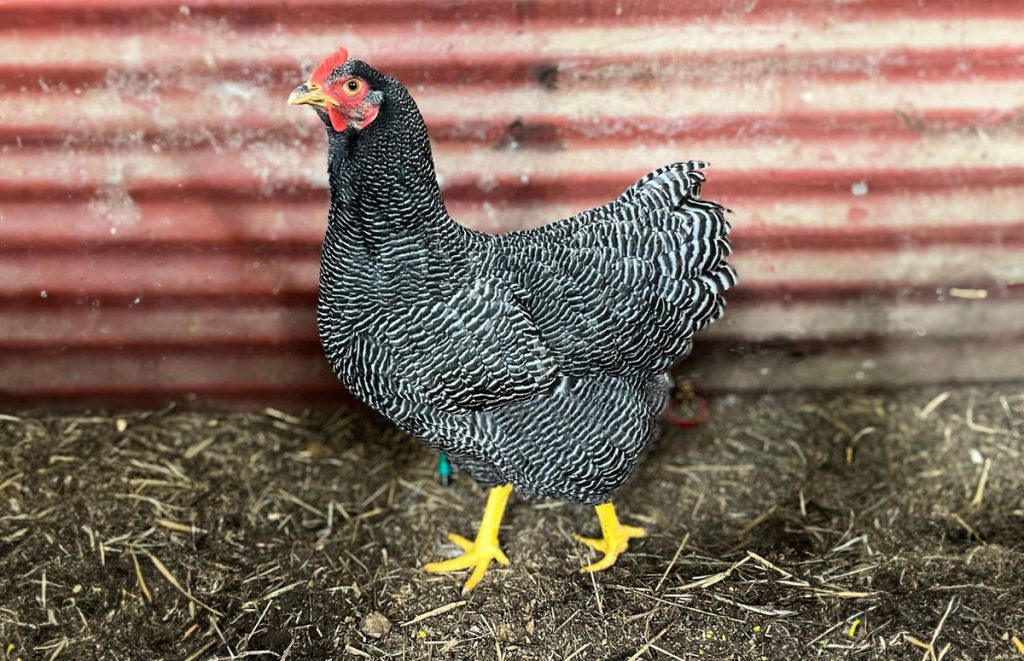
5. Plymouth Rock
The Plymouth Rock, or Barred Rock, is a popular American breed used for both eggs and meat. They rank in the top 5 in 33 states. Hens lay around 200 eggs annually. They are easy to care for and very hardy, making them well-suited for various settings.
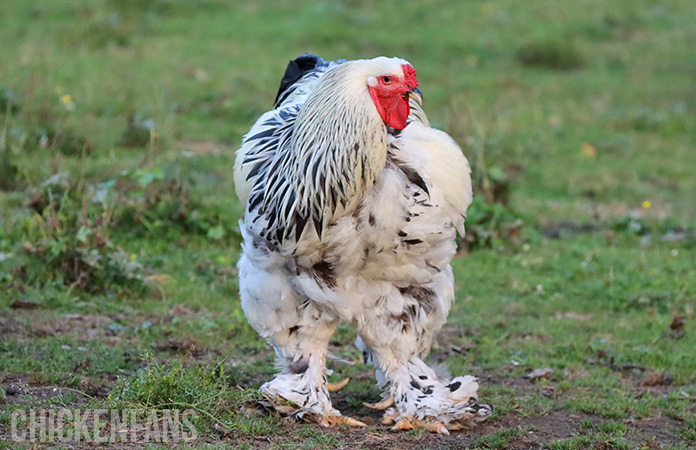
6. Brahma
Brahmas are giant – but gentle – chickens with feathered feet, often called the King of Poultry. Hens can lay up to 300 eggs per year. They made the top 5 in 29 states, and with their rich feathering, they are the number one in Alaska and North Dakota.
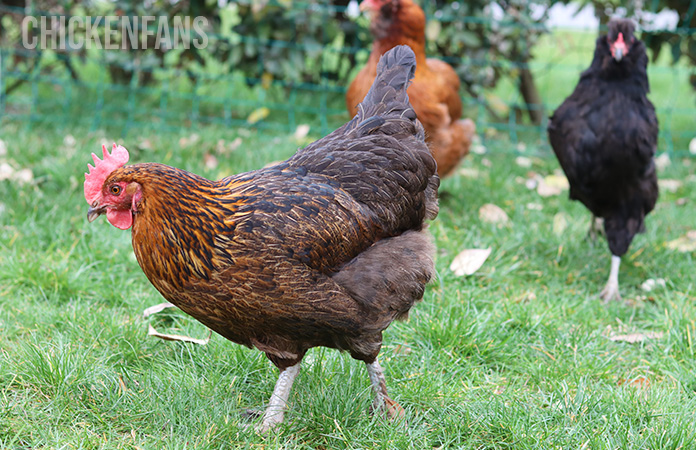
7. Marans
The Marans is a French breed that lays around 200 large dark chocolate-brown eggs per year. They made the top 5 in 13 states and reached 2nd place in Washington, with the Cuckoo Marans and Black Copper Marans on the rise.
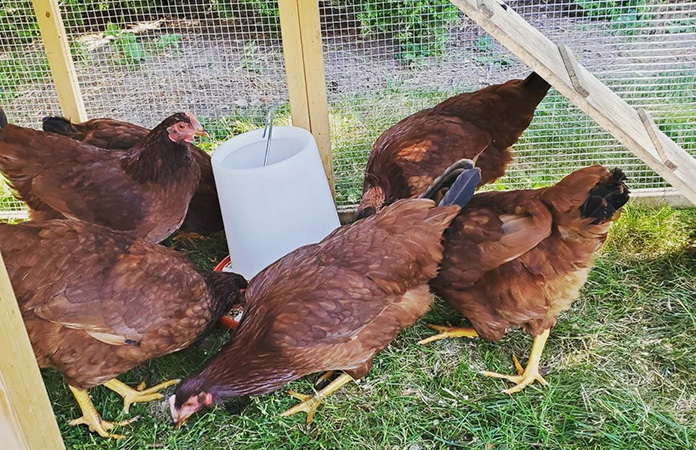
8. Rhode Island Red
The Rhode Island Red is a hardy, practical breed, originally created in Rhode Island, where it’s the most popular. Hens lay up to 250 eggs per year. They made the top 5 in 11 states. They are often used to create new hybrids and hatchery mixes.
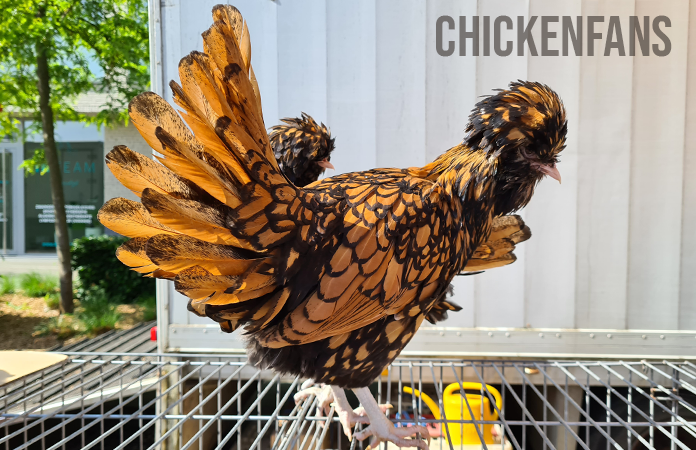
9. Polish Chicken
The Polish Chicken is a popular exhibition breed with a distinctive crest that resembles a hairdo. Their iconic look makes them the 4th most-searched-for breed in Connecticut. They lay about 150 medium white eggs per year.
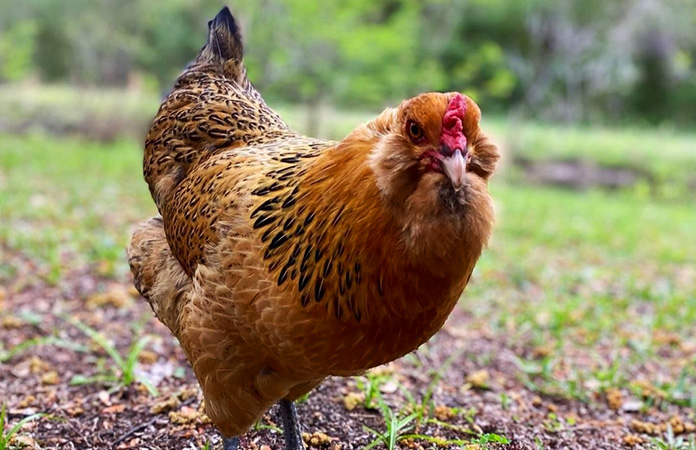
10. Ameraucana
The Ameraucana is an American chicken breed that’s wanted for its blue eggs. They are muffed and bearded and provide up to 200 eggs per year. Ameraucanas are especially popular in Idaho, where they reached 3rd place in the popularity charts.
Beyond the Top 10: Lesser-Explored Chicken Breeds
Three chicken breeds have just missed making it into the overall top 10: The Jersey Giant, Ayam Cemani, and Araucana.
The Rhode Island White, not widely popular across the country, earns a special accolade by making it into the top five chicken breeds exclusively in Rhode Island.
11. Jersey Giant
The Jersey Giant is one of the largest breeds in terms of weight. It’s an American breed, developed in the United States as a dual-purpose breed. Hens lay 150-200 eggs per year. Its origins trace back to the late 19th century in New Jersey.
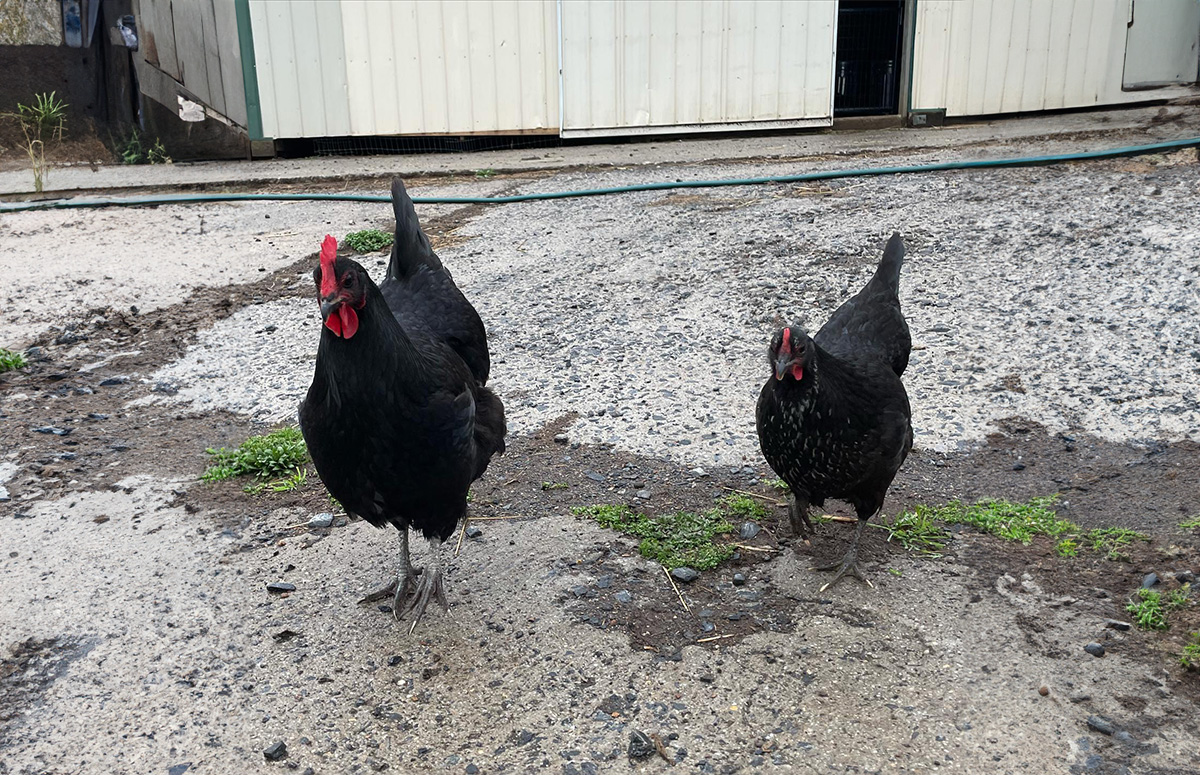
Despite its impressive size and friendly nature, the Jersey Giant is not as widely spread across the states. It entered the top 5 in New Mexico, New Jersey, and Michigan. New Jersey, where the Brahmas also made it into the top 5, has a soft spot for gigantic chickens.
Its popularity in Michigan, particularly in areas like Lansing, Grand Ledge, and Delhi Charter Township, coincides with the locations of Jersey Giant Subs, a popular sandwich bar chain. Search engines probably misinterpret people searching for the sandwich bar as looking for the chicken breed.
12. Ayam Cemani
The Ayam Cemani is famous for its all-black appearance, including feathers, skin, and organs, a trait caused by a genetic condition known as fibromelanosis. Originating from Indonesia, this breed has garnered worldwide attention for its unique and exotic appearance, making it a highly sought-after breed for collectors and those interested in ornamental birds rather than for its egg-laying capabilities.
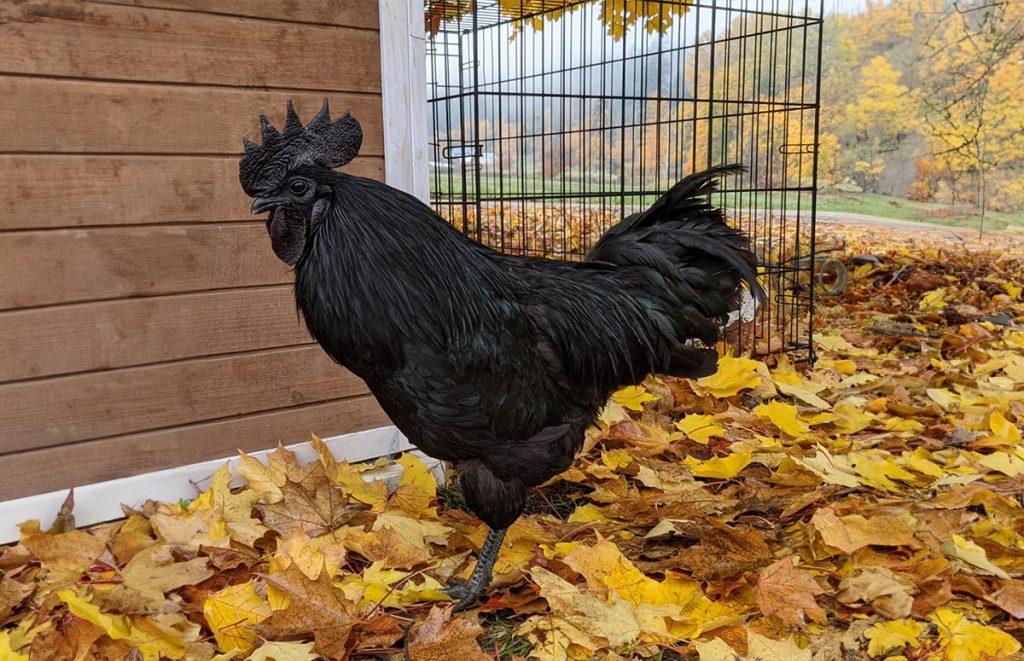
The Ayam Cemani is especially popular in Hawaii, where it is the second most searched-for chicken breed after Silkies. The Ayam Cemani also comes in 6th place in California, narrowly missing the top 5.
13. Araucana
The Araucana, coming from Chile, is famous for its blue eggs, which makes it popular among chicken keepers who want to add a splash of color to their egg baskets. They have an iconic look with tufted ears and the absence of a tail. The Araucana was used to create both the Ameraucana (blue eggs) and the “Easter egger” hybrids (olive eggs).
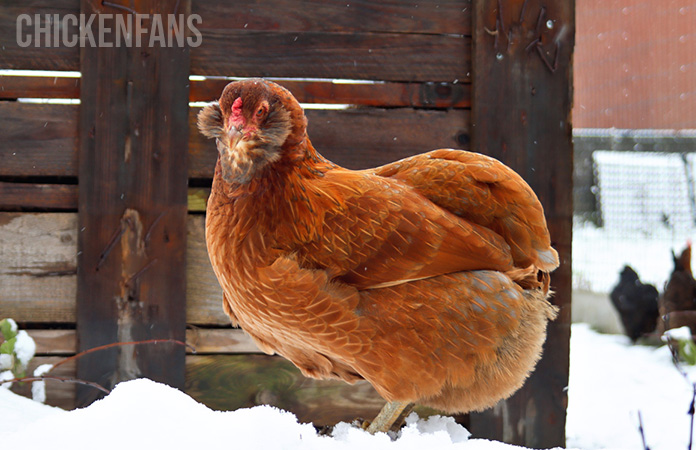
While the Ameraucana reached the top 5 in states like Idaho and Montana, the Araucana didn’t quite make the cut. Nevertheless, they continue to enjoy popularity, especially in Delaware, where they secured the 6th spot.
How We Analyzed Chicken Breed Preferences
Data collection: The data for our research is primarily sourced from analytics and proprietary data collected from our website, chickenfans.com, encompassing search queries and popular articles. We also incorporate Google Trends data and search volumes. Additionally, various supplementary resources, including Wikipedia, academic papers, and newspapers, complement our dataset. This data collection spans from 2023 to early 2024.
Geographical Data: Our primary criterion revolves around searches, focusing on the most searched-for chicken breeds in each state. The analysis delves into local searches, emphasizing the distribution of breed popularity within regions, considering that some sparsely populated areas exhibit concentrated interest. The statistical regions used by Google Trends are internally defined. We occasionally reference Metropolitan Statistical Areas and other named areas. For example, we refer to New England as comprising Connecticut, Maine, Massachusetts, New Hampshire, Rhode Island, and Vermont.
Analysis: data analysis is primarily done with Python using libraries like Pandas, NumPy, and Matplotlib. Charts are generated with Matplotlib, Pyplot, and choropleth maps of US states are manually created with MapChart. We exclusively focus on breed searches in Google Trends, excluding broader search terms or topics to maintain data quality. Nonetheless, there are limitations to consider, such as the data being a sample of searches, privacy concerns leading to aggregated data, and occasional misinterpretation of queries by search engines. Despite these limitations, our research captures meaningful trends in chicken breed popularity.






















